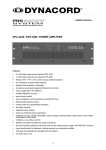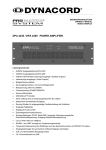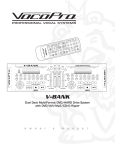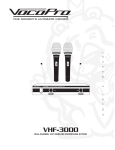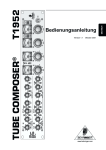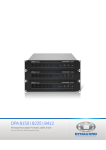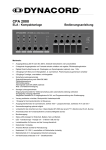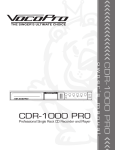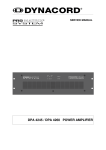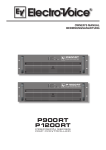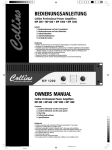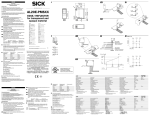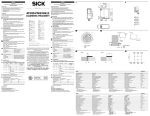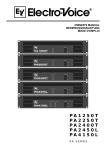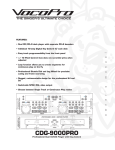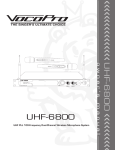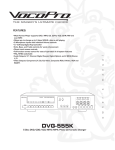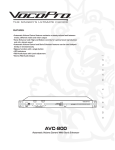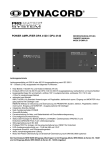Download Dynacord DPA 4245 Stereo Amplifier User Manual
Transcript
BEDIENUNGSANLEITUNG OWNER‘S MANUAL MODE D‘EMPLOI DPA 4245 / DPA 4260 POWER AMPLIFIER CH B CH A LIMIT SIGNAL PROTECT POWER DPA 4245 2 x 450 WATTS POWER AMPLIFIER Leistungsmerkmale • • • • • • • • • • • • • • • • • • • • • • • 2x450W Ausgangsleistung DPA 4245 2x600W Ausgangsleistung DPA 4260 erdfreie 100V/70V/25V Leistungs-Ausgänge ( Isolated Outputs ) niederohmige Ausgänge ( Direct Outputs ) Bridged Mode schaltbar alle Ausgänge leerlauf- und kurzschlußgeschützt Netzspannung 230V AC 50/60Hz Ferneinschaltung POWER REMOTE Service-Netzschalter GROUND-LIFT Schalter aktive Lüftung mit je 2 temperaturgesteuerten DC-Lüftern elektronisch symmetrische Eingänge Routing Schalter für eingangsseitige Parallelschaltung der Endstufen Eingangs-Pegelsteller Eingebaute Audio Limiter Einschaltgeräuschunterdrückung Schutzschaltungen: DC/HF, Back-EMF, Ausgangs -Überspannungslimiter, Einschaltstrombegrenzung, Ausgangs-Spitzenstrombegrenzung LO-Cut Filter 45Hz mit 18dB/oct. SIGNAL- und LIMIT-Anzeige zur Aussteuerungskontrolle Temperatur-Überwachung der Kühlkörper und des Netztransformators mit PROTECT-Funktion Eingangsübertrager für symmetrisch-erdfreie Eingänge nachrüstbar XLR- und Schraubsteck-Eingangsbuchsen 19“- Einschubchassis mit 3HE WICHTIGE SICHERHEITSHINWEISE Das Blitzsymbol innerhalb eines gleichseitigen Dreiecks soll den Anwender auf nicht isolierte Leitungen und Kontakte im Geräteinneren hinweisen, an denen hohe Spannungen anliegen, die im Fall einer Berührung zu lebensgefährlichen Stromschlägen führen können. 1. 2. 3. 4. 5. 6. 7. 8. 9. 10. 11. 12. 13. 14. 15. 16. Das Ausrufezeichen innerhalb eines gleichseitigen Dreiecks soll den Anwender auf wichtige Bedienungssowie Servicehinweise in der zum Gerät gehörenden Literatur aufmerksam machen. Lesen Sie diese Hinweise. Heben Sie diese Hinweise auf. Beachten Sie alle Warnungen. Richten Sie sich nach den Anweisungen. Betreiben Sie das Gerät nicht in unmittelbarer Nähe von Wasser. Verwenden Sie zum Reinigen des Gerätes ausschließlich ein trockenes Tuch. Verdecken Sie keine Lüftungsschlitze. Beachten Sie bei der Installation des Gerätes stets die entsprechenden Hinweise des Herstellers. Vermeiden Sie die Installation des Gerätes in der Nähe von Heizkörpern, Wärmespeichern, Öfen oder anderer Wärmequellen. Achtung: Gerät nur an Netzsteckdose mit Schutzleiteranschluss betreiben. Setzen Sie die Funktion des Schutzleiteranschlusses des mitgelieferten Netzanschlusskabels nicht außer Kraft. Sollte der Stecker des mitgelieferten Kabels nicht in Ihre Netzsteckdose passen, setzen Sie sich mit Ihrem Elektriker in Verbindung. Sorgen Sie dafür, dass das Netzkabel nicht betreten wird. Schützen Sie das Netzkabel vor Quetschungen insbesondere am Gerätestecker und am Netzstecker. Verwenden Sie mit dem Gerät ausschließlich Zubehör/Erweiterungen, die vom Hersteller hierzu vorgesehen sind. Ziehen Sie bei Blitzschlaggefahr oder bei längerem Nichtgebrauch den Netzstecker. Überlassen Sie sämtliche Servicearbeiten und Reparaturen einem ausgebildeten Kundendiensttechniker. Servicearbeiten sind notwendig, sobald das Gerät auf irgendeine Weise beschädigt wurde, wie z.B. eine Beschädigung des Netzkabels oder des Netzsteckers, wenn eine Flüssigkeit in das Gerät geschüttet wurde oder ein Gegenstand in das Gerät gefallen ist, wenn das Gerät Regen oder Feuchtigkeit ausgesetzt wurde, oder wenn es nicht normal arbeitet oder fallengelassen wurde. Stellen Sie bitte sicher, dass kein Tropf- oder Spritzwasser ins Geräteinnere eindringen kann. Stellen Sie keine mit Flüssigkeiten gefüllten Objekte, wie Vasen oder Trinkgefässe, auf das Gerät. Um das Gerät komplett spannungsfrei zu schalten, muss der Netzstecker gezogen werden. Beim Einbau des Gerätes ist zu beachten, dass der Netzstecker leicht zugänglich bleibt. Entsorgung von gebrauchten elektrischen und elektronischen Geräten (Anzuwenden in den Ländern der Europäischen Union und anderen europäischen Ländern mit einem separaten Sammelsystem für diese Geräte) Das Symbol auf dem Produkt oder seiner Verpackung weist darauf hin, dass dieses Produkt nicht als normaler Haushaltsabfall zu behandeln ist, sondern bei einem Telex Händler abgegeben werden muss. WICHTIGE SERVICEHINWEISE ACHTUNG: Diese Servicehinweise sind ausschliesslich für qualifiziertes Servicepersonal vorgesehen. Um die Gefahr eines elektrischen Schlages zu vermeiden, führen Sie keine Wartungsarbeiten durch, die nicht in der Bedienungsanleitung beschrieben sind, ausser Sie sind hierfür qualifiziert. Überlassen Sie sämtliche Servicearbeiten und Reparaturen einem ausgebildeten Kundendiensttechniker. 1. Bei Reparaturarbeiten im Gerät sind die Sicherheitsbestimmungen nach EN 60065 (VDE 0860) einzuhalten. 2. Bei allen Arbeiten, bei denen das geöffnete Gerät mit Netzspannung verbunden ist und betrieben wird, ist ein Netz trenntransformator zu verwenden. 3. Vor einem Umbau mit Nachrüstsätzen, Umschaltung der Netzspannung oder sonstigen Modifikationen ist das Gerät stromlos zu schalten. 4. Die Mindestabstände zwischen netzspannungsführenden Teilen und berührbaren Metallteilen (Metallgehäuse) bzw. zwischen den Netzpolen betragen 3 mm und sind unbedingt einzuhalten. Die Mindestabstände zwischen netzspannungsführenden Teilen und Schaltungsteilen, die nicht mit dem Netz verbunden sind (sekundär), betragen 6 mm und sind unbedingt einzuhalten. 5. Spezielle Bauteile, die im Stromlaufplan mit dem Sicherheitssymbol gekennzeichnet sind (Note), dürfen nur durch Originalteile ersetzt werden. 6. Eigenmächtige Schaltungsänderungen dürfen nicht vorgenommen werden. 7. Die am Reparaturort gültigen Schutzbestimmungen der Berufsgenossenschaften sind einzuhalten. Hierzu gehört auch die Beschaffenheit des Arbeitsplatzes. 8. Die Vorschriften im Umgang mit MOS - Bauteilen sind zu beachten. NOTE: SAFETY COMPONENT ( MUST BE REPLACED BY ORIGINAL PART ) 2 INHALTSVERZEICHNIS Beschreibung ......................................................................................... Insallationshinweise .............................................................................. Rückseite .............................................................................................. Eingänge ............................................................................................... Ausgänge .............................................................................................. Technische Daten .................................................................................. Block Diagramm .................................................................................... Abmessungen ....................................................................................... 3 4 5 5 6 13 43 44 BESCHREIBUNG Die Endstufen der DPA-Serie sind speziell für den Einsatz im Festinstallationsbereich ausgelegt und gewähren somit den leistungssicheren und zuverlässigen Betrieb von PA-Systemen mit je 2 unabhängigen Lautsprecherkreisen. Die DPA-Serie ist daher besonders für Ruf- und Durchsageanlagen, Alarmierungsanlagen und für Musikübertragung in Industriebetrieben, Büro- und Geschäftsräumen, Versammlungs- und Sportstätten, Schulen und Kirchen, Hotels, Krankenhäusern, Supermärkten, Fahrgastschiffen und andere ähnliche Anwendungen geeignet. Die Endstufen sind mit je 2 Hochleistungs-Ausgangstransformatoren bestückt und stellen die 100V, 70V und 25V Ausgänge erdfrei zur Verfügung. Zusätzlich besteht die Möglichkeit über die Direct Outputs auch niederohmige Lautsprechersysteme bis zu einer minimalen Impedanz von 4 Ohm zu treiben. Der gleichzeitige Betrieb an einem Endstufenkanal von niederohmigen Lautsprechersystemen und erdfreien Lautsprecherlinien ist möglich. Durch das eingebaute LO-Cut Filter bei 45Hz mit einer Flankensteilheit von 18dB/oct werden die angeschlossen Lautsprecherlinien sicher gegen ungewünschte tieffrequente Signale geschützt. Komparatorschaltungen vergleichen ständig das Eingangs- und Ausgangssignal der Endstufen und steuern beim Auftreten von nichtlinearen Betriebszuständen die eingebauten Limiter. Sie schützen die angeschlossenen Lautsprecher vor Überlast durch Endstufenclipping, Trafosättigung oder Überspannung am Ausgang. Die Übertragungseigenschaften der DPA-Endstufen sind hervorragend. Durch groß dimensionierte Netzteile mit streuarmen Ringkerntransformatoren wird die ausgewiesene Nennleistungen auch in kritischen Installationen sicher erreicht. In der DPA-Serie wurde auf die Verwendung von V/I-Foldback-Limiter-Schaltungen verzichtet, so daß der Betrieb an komplexen Lasten bis zu +/- 90° Phasenwinkel problemlos möglich ist. Eine schnelle Auskunft über den Betriebszustand der Endstufen vermittelt das leicht ablesbare LED-Display. Für beide Kanäle wird übersichtlich angezeigt, ob Betriebsbereitschaft gegeben ist, ob ein Signal am Ausgang anliegt, wann die Limiter ansprechen und ob eine der Schutzschaltungen aktiv ist. Die Eingänge sind elektronisch symmetrisch auf XLR-Buchsen bzw. auf Schraub-Steckverbindungen gelegt. Durch die eingangsseitige Parallelschaltung der beiden Anschlußvarianten wird ein Durchschleifen zu weiteren Endstufen ohne spezielle Split-Kabel einfach ermöglicht. Beide Eingänge können optional mit Eingangsübertrager ausgerüstet werden. Zusätzlich können über die Input Routing Schalter die Endstufen auf Stereo-, Parallel-Mono- und Bridged-Mode konfiguriert werden. Auf der Rückseite sitzen die in dB-skalierten Levelregler, die als besonders präzise, bediensichere Potis ausgeführt sind und ein Ground-Lift-Schalter, der das Gehäuse von der Schaltungsmasse trennt und dadurch Brummschleifen verhindern hilft. Der Anschluß der Lautsprecherlinien an die Endstufen erfolgt über LeistungsSchraubsteckverbindungen, wobei alle Spannungen 25V, 70V, 100V und der Low Impedance Ausgang zur einfachen Anpassung direkt nach außen geführt sind. Die Endstufe kann über einen an der Rückwand montierten Service-Netzschalter oder über den Power Remote Eingang per Ferneinschaltung in Betrieb genommen werden. Die thermische Stabilität der Endstufen wird durch extrem leise laufende Lüfter, die je nach Betriebszustand stufenweise hochgeschaltet werden, gewährleistet. Die Luftführung ist dabei Front-to-Rear, wodurch der problemlose Betrieb in großen und schmalen Einbauschränken gewährleistet ist. Mit dieser Bedienungsanleitung werden Sie noch viele weitere Eigenschaften der Endstufen aus der DPA-Serie kennenlernen. Lesen Sie deshalb bitte aufmerksam weiter. 3 Installationshinweise Generell sind die Endstufe so aufzustellen oder zu montieren, daß die Luftzufuhr an der Frontseite und die Entlüftung an der Geräterückseite nicht behindert wird.Für den Einbau in Gehäuse und Gestellschränke ist zu beachten, daß eine ausreichende Belüftung der Geräte möglich ist. Zwischen der Endstufen Rückseite und der Schrank/Rack-Innenseite ist ein freier Luftkanal bis zur oberen Rack-oder Schrankentlüftung von mindestens 60mm x 330mm vorzusehen. Oberhalb des Schrankes soll ein freier Raum von mindestens 100mm für die Entlüftung vorgesehen werden. Da beim Betrieb die Temperatur im Gehäuse- oder Schrank bis zu 40°C ansteigen kann, muß die maximal zulässige Umgebungstemperatur der übrigen im Gestellschrank befindlichen Module und Baugruppen beachtet werden. Beim Einbau in Gestellschränken sollen in jedem Fall Einbauschienen oder die als Zubehör erhältlichen Rackeinbauwinkel NRS 90235 (112733) verwendet werden, um ein Verwinden der Frontblende zu verhindern. Hinweis Die max. Umgebungstemperatur von +40°C soll für störungsfreien Betrieb nicht überschritten werden. Die Endstufe ist zu schützen vor: - Tropf- oder Spritzwasser - direkter Sonnenbestrahlung - hoher Umgebungstemperatur oder unmittelbarer Einwirkung von Wärmequellen - hoher Luftfeuchtigkeit - starken Staubablagerungen - starken Vibrationen Wenn die Endstufe direkt von einem kalten an einen warmen Ort gebracht wird, kann sich Feuchtigkeit auf Innenteilen niederschlagen. Das Gerät darf erst in Betrieb genommen werden, wenn es sich auf die geänderte Temperatur erwärmt hat (nach etwa einer Stunde).Sollte ein fester Gegenstand oder Flüssigkeit in das Gehäuse gelangen, trennen Sie sofort die Stromquellen vom Gerät ab und lassen das Gerät von einer DYNACORD Servicestelle überprüfen, bevor Sie es weiterverwenden.Zur Reinigung des Gerätes dürfen keine Sprühmittel verwendet werden, da diese dem Gerät schaden und sich plötzlich entzünden können. Vor der Inbetriebnahme Vor dem Einschalten des Gerätes ist das mitgelieferte Netzanschlußkabel an eine 230V - 50/60Hz Netzsteckdose anzuschließen. Am Gerät ist das Netzanschlußkabel an den 3-poligen Kaltgeräte-Stecker anzustecken.Zum Betrieb des Verstärkers mit Ferneinschaltung ist eine externe 24V-Gleichspannung an die Stiftleiste POWER REMOTE anzuschließen. Bei richtigem Anschluß und vorhandener Spannung leuchtet die POWER ON Anzeige und die Endstufe ist betriebsbereit.Für Servicezwecke ist der Netzschalter POWER an der Geräterückseite vorgesehen, mit dem das Netz-Einschaltrelais überbrückt wird. In diesem Fall kann der Verstärker ohne externe 24V-Gleichspannung in Betrieb genommen werden. Achtung Der Netzschalter POWER an der Geräterückseite ist nur für Servicezwecke vorgesehen. Eine Fernbedienung ist bei eingeschaltetem POWER Schalter nicht möglich. Die DPA-Endstufen sind zur Vermeidung von Einschaltgeräuschen mit einer Einschaltverzögerung von ca. 2s ausgestattet. 4 230V 50-60 Hz 870 WATTS CAUTION CHANNEL B INPUTS RISK OF ELECTRIC SHOCK DO NOT OPEN T CIRCUIT TO CHASSIS SWITCH MAINS FUSE T10A/L/250V POWER GROUNDED UNGROUNDED SEE OPERATING MANUAL! WARNING: TO REDUCE THE RISK OF FIRE OR ELECTRIC SHOCK, DO NOT EXPOSE THIS APPLIANCE TO RAIN OR MOISTURE. CAUTION: FOR CONTINUED PROTECTION AGAINST RISK OF FIRE REPLACE WITH SAME TYPE AND VALUE FUSE INDICATED. ATTENTION: REMPLACER PAR UN FUSIBLE DE MEME TYPE + POWER REMOTE + +24V 0V INPUT ROUTING -6 -5 -4 -6 -5 -4 -9 -3 -3 DUAL -12 -2 -2 -16 -1 -1 -30 0 dB 0 dB LEVEL ON OFF PARALLEL DPA 4260 AVIS: RISQUE DE CHOC ELECTRIQUE. NE PAS OUVRIR. COMME INDIQUE. -9 -12 -16 -30 CHANNEL A INPUTS + LEVEL 121715 MADE IN GERMANY AUDIO TRANSFORMER OUTPUTS B + 25V A LOW IMPEDANCE + 100V BRIDGED + 1200W/8 + 70V + B DUAL 600W 4 A 100V + 70V + 25V + + 100 70 0 DIRECT OUTPUTS 0 70 100 ISOLATED OUTPUTS BRIDGED MODE NORMAL BRIDGED OUTPUT WIRING MUST BE CLASS 1 NO USER SERVICEABLE PARTS INSIDE. REFER SERVICING TO QUALIFIED SERVICE PERSONNEL. Eingänge INPUT CHANNEL A&B + S -- PIN 1: SHIELD PIN 2: a, + PIN 3: b, - Die Eingänge INPUT CHANNEL A&B sind elektronisch symmetrisch mit einer Eingangsempfindlichkeit von 775mV = 0 dBu für den Betrieb mit Steuerverstärkern, Audio Controllern, Mischpulten usw. ausgelegt. Die Eingangsimpedanz liegt bei 20kOhm symmetrisch. Der Anschluß peripherer Geräte kann entweder über die XLR-Eingangsbuchsen oder die parallelgeschalteten Schraubsteckverbindungen, die im Lieferumfang enthalten sind, erfolgen. Das „Durchschleifen“ des Signals zu weiteren Endstufen ist durch die direkte Parallelschaltung der beiden Anschlußvarianten ohne aufwendige Splitkabel möglich. Die XLR-Eingangsbuchsen sind nach IEC Norm 268 beschaltet: + Stellt das Steuergerät keinen symmetrischen Ausgang zur Verfügung, können die Endstufeneingänge auch unsymmetrisch beschaltet werden. Dazu wird der Masse- bzw. Chassisanschluß (Pin1) mit dem - Eingang (Pin3) verbunden. Das Signal wird dann über den + Eingang (Pin2) eingespeist. Um jedoch die Vorteile der elektronisch symmetrischen Eingangsstufe, wie Brumm- und Störsignalunterdrückung im vollen Umfang zu nutzen, sollte sobald die Möglichkeit besteht auf die symmetrische Eingangsverdrahtung zurückgegriffen werden.Für den Fall, daß die Eingänge potentialfrei sein müssen, sind diese für die Nachrüstung von Eingangsübertrager vorgesehen. Es wird dazu je Kanal der Nachrüstsatz NRS 90208 (308840) benötigt. Nachrüstanleitung Eingangsübertrager NRS 90208 • • • • • • • • Netzstecker ziehen Alle Schrauben zur Haubenbefestigung entfernen Öffnen des Gerätes durch Abnehmen der Abdeckhaube (Deckel) Flachbandkabel an Printplatte 81340/1 abstecken Schrauben zur Befestigung der Printplatte 81340/1 entfernen Printplatte 81340/1 herausnehmen und die Widerstände R106 ... R109 auslöten. Bestückung der Eingangsübertrager mit Isolierscheiben entsprechend Markierung auf der Printplatte. Zusammenbau des Gerätes in umgekehrter Reihenfolge 5 Bild: Schaltbild Input Channel A -9 -12 -16 -30 Bild: Platinenbereich Channel A Übertragereinbau Level-Regler In dB skalierte Drehregler zur Anpassung der Gesamtverstärkung der Endstufe. Zur Vermeidung von Verzerrungen in vorgeschalteten Geräten, sollte dieser Regler normalerweise zwischen 0dB und -6dB eingestellt werden. Die Beschriftung zeigt unmittelbar die zusätzliche Dämpfung, mit der die intern festgelegte Verstärkung verändert wird. -6 -5 -4 -3 -2 -1 0 dB LEVEL Input-Routing Steht der Druckschalter in Position Parallel/Mono sind die Eingangsbuchsen CHANNEL A und CHANNEL B elektrisch direkt parallel geschaltet. Mit nur einer angeschlossenen Signalquelle können beide Kanäle ausgesteuert werden. Die Lautstärke für Kanal A oder B wird nach wie vor unabhängig voneinander über die Level-Regler A und B eingestellt. INPUT ROUTING DUAL/STEREO PARALLEL/MONO Steht der Druckschalter in Position Dual/Stereo werden Kanal A und B getrennt voneinander verstärkt (Zweikanal- oder Stereobetrieb). Leistungsausgänge A&B Über eine Leistungs-Schraubsteckverbindung, die im Lieferumfang enthalten ist, werden die Lautsprecherleitungen mit dem Gerät verbunden. Der 12-polige Stecker kann zur einfachen Montage abgezogen werden. Die Schraubsteckverbindung kann maximal mit einem Leitungsquerschnitt von 2.5 mm2 belegt werden. Um einen möglichst variablen Anschluß zu gewährleisten, stehen an der Steckerleiste alle potentailfreien Ausgangsspannungen 25V, 70V und 100V (ISOLATED OUTPUTS) sowie der niederohmige Ausgang (DIRECT OUTPUTS) für beide Kanäle zur Verfügung. AUDIO TRANSFORMER OUTPUTS B LOW IMPEDANCE 100V + BRIDGED + 1200W/8 + 100V + 25V + 70V + B DUAL 600W 4 A A 70V + + 100 70 0 DIRECT OUTPUTS 0 70 100 ISOLATED OUTPUTS Bild: Leistungsausgänge DPA 4260 6 25V + Leistungsausgänge AUDIO TRANSFORMER OUTPUTS Über zwei eingebaute Audio-Ausgangsübertrager wird die Nennausgangsspannung der Endstufe auf die meist verwendeten Spannungen 25V, 70V und 100V für Lautsprechernetze transformiert. Alle Spannungen stehen gleichzeitig an den Ausgangsklemmen potentialfrei zur Verfügung. Die beiden Endstufenkanäle können in beliebigen Kombinationen der möglichen Ausgangsspannungen verwendet werden. Ein gemischter Betrieb an einem Endstufenkanal von niederohmigen Lautsprechersystemen und erdfreien Lautsprecherlinien ist möglich. Vorsicht Die Ausgänge können im Betrieb berührungsgefährliche Spannungswerte (>34V Spitzenwert) annehmen. Die angeschlossenen Lautsprecherkreise sind aus diesem Grunde gemäß den geltenden Sicherheitsbestimmungen zu installieren. Für das Errichten und Betreiben von100V-Lautsprecheranlagen ist die VDE-Bestimmung DIN VDE 0800 zu beachten. Besonders bei 100V-Lautsprecheranlagen für Alamierungszwecke sind alle Schutzmaßnahmen für die Bemessungsklasse 3 auszulegen. Der Lautsprecher-Anschlußklemmblock muß vor Inbetriebnahme der Endstufe mit dem beiliegenden Isoliergehäuse versehen werden. Leistungsausgänge Isolated Outputs 70V und 100V Wenn die Entfernung zwischen Endstufe und Lautsprecher mehr als 50m beträgt, wird empfohlen, Lautsprecher mit 100V oder 70V Anpassungsübertrager zu verwenden um die Leitungsverluste zu verringern. Dadurch wird auch eine einfache Verteilung der Ausgangsleistung auf die einzelnen Systeme ermöglicht.Es können maximal so viele Lautsprecher angeschlossen werden, bis die Gesamtleistungsaufnahme des Lautsprechernetzes dem Nennleistungswert der Endstufe entsprich, wobei der Nennlastwiderstand der Endstufenausgänge nicht unterschritten werden soll.Die Nennleistungswerte sowie die Nennlastwiderstände der einzelnen Ausgänge entnehmen Sie bitte den Technischen Daten im Anhang. AUDIO TRANSFORMER OUTPUTS B LOW IMPEDANCE + 100V + 25V BRIDGED + 1200W/8 + 70V + B DUAL 600W 4 A A 100V + 70V + 25V + + 100 70 0 DIRECT OUTPUTS 0 70 100 ISOLATED OUTPUTS 100 V 30 W 100 V 30 W 100 V 6W Bild: 100 V 6W 16 x 30 W 83 x 6 W Beispielbeschaltung DPA4260 mit 100V Lautsprechern. Maximale Auslastung mit Lautsprechern 30W/100V und 6W/100V. 7 Leistungsausgänge Isolated Outputs 25V Der 25V Ausgang dient im wesentlichen zur potentialfreien Ansteuerung von niederohmigen Lautsprechern ( 4-16 Ohm). Wegen der Leitungsverluste soll die Entfernung zwischen den Lautsprechern und dem Verstärker nicht mehr als 50 m betragen. Es ist darauf zu achten, daß die Gesamtimpedanz des Lautsprechernetzes den Nennlastwiderstand für den 25V-Ausgang nicht unterschreitet. Den Nennlastwiderstand des 25V-Ausgangs entnehmen Sie bitte ebenfalls den Technischen Daten im Anhang. AUDIO TRANSFORMER OUTPUTS B + 100V + 25V A LOW IMPEDANCE BRIDGED + 1200W/8 + 70V + B DUAL 600W 4 A 100V + 70V + 25V + + 100 70 0 DIRECT OUTPUTS 0 70 100 ISOLATED OUTPUTS 8 16 8 6x8 12 x 16 16 Bild: Beispielbeschaltung DPA4260 mit 8 Ohm und 16 Ohm Lautsprechern bei maximaler Auslastung Leistungsausgänge DIRECT OUTPUTS Zum Antrieb von niederohmigen Hochleistungs-Lautsprechersystemen ist zusätzlich zu den Ausgängen des Ausgangsübertragers auch der niederohmige Ausgang der Endstufe herausgeführt. Die minimale Lastimpedanz beträgt hier 4 Ohm. Jeder Kanal der Endstufe kann gleichzeitig Lasten am Direct Output und am Isolated Output treiben. Es muß jedoch unbedingt darauf geachtet werden, daß die Gesamtleistungsaufnahme der Lautsprecher oder Lautsprecherlinien die Nennleistung der Endstufe nicht übersteigt. Beispiel: Wird am DPA4260 Channel A Direct Output eine Lautsprecherbox mit 8 Ohm und einer Nennleistung von mindestens 300W angeschlossen, ist genau die Hälfte der Leistungskapazität der Endstufe ausgeschöpft, da die minimale Lastimpedanz je Kanal 4 Ohm beträgt. Es kann dann noch die Hälfte der Nennausgangsleistung des Channel A 100V-Ausgangs, in diesem Fall 500W/2 = 250W, für eine verteilte Lautsprecherlinie abgenommen werden. Die Gesamtimpedanz der Lautsprecherlinie darf also hier 20Ohm*2 = 40 Ohm nicht unterschreiten. AUDIO TRANSFORMER OUTPUTS B LOW IMPEDANCE + 100V + 25V BRIDGED + 1200W/8 + 70V + B DUAL 600W 4 A A 100V + 70V + 25V + + 100 70 0 DIRECT OUTPUTS 0 70 100 ISOLATED OUTPUTS 10 x 25 W/100V 8 /300 W Bild: Beispielbeschaltung DPA4260 Kanal A im gemischten Betrieb 8 Bridged Mode Um die Ausgangsspannung der Endstufe zu verdoppeln, wird die Endstufe in Bridged Mode geschaltet. Die beiden Endstufenblöcke werden dazu im Gegentakt betrieben. Es wird also sozusagen eine Monoendstufe erzeugt, mit der doppelten Ausgangsspannung und Ausgangsleistung eine Einzelkanals. Dadurch stehen potentialfrei 50V, 140V und 200V sowie ein Direct Output mit verdoppelter Nennausgansspannung zur Verfügung. Ist der Schalter BRIDGED-MODE gedrückt muß das Signal über CHANNEL A Input eingespeist werden und der CHANNEL B Input ist dann ohne Funktion. Das Signal wird intern invertiert und steuert den Endstufenblock B mit dem invertierten Eingangssignal an, wobei der Endstufenblock A nach wie vor mit dem nichtinvertierten Eingangssignal angesteuert wird. Die Verwendung des Bridged Mode ist sowohl mit den Direct Outputs als auch über die Isolated Outputs möglich. Bei den Isolated Outputs müssen die “Minus”- Klemmen der Kanäle A und B über eine Drahtbrücke mit ausreichendem Querschnitt (1,5mm2 .... 2,5mm2) verbunden werden! Um Phasenfehler zu vermeiden, ist unbedingt die richtige Anschlußart der Lautsprecher zu beachten. Kanal A führt das Signal “in Phase” und muß dadurch mit dem + Pol des jeweiligen Lautsprechers verbunden werden. Der - Pol des Lautsprechers muß dann am + Ausgang des Kanal B angeschlossen werden. Die Ausgangsspannung jedes einzelnen Endstufenblocks A&B steht zwar an der Steckerleiste, soll aber wegen der Phasendrehung nicht mehr weiter benutzt werden. AUDIO TRANSFORMER OUTPUTS B + 100V + 25V A LOW IMPEDANCE BRIDGED + 1200W/8 + 70V + B DUAL 600W 4 A 100V + 70V + 25V + + BRIDGED 50 V 100 70 0 DIRECT OUTPUTS 0 70 100 ISOLATED OUTPUTS + * 50V .....1000 W Bild: Ausgangsbuchse im 50V Bridged Mode * Achtung! Der Querschnitt der Drahtbrücke muß mindestens 1,5mm2 betragen. Der Betrieb von 4 Ohm Lasten am Direct Output ist im Bridged Mode nicht zulässig. Die Nennleistungswerte sowie die Nennlastwiderstände der einzelnen Ausgänge im Bridged Mode für die Isolated Outputs entnehmen Sie bitte den Technischen Daten im Anhang. Die Nennlastimpedanz darf auch hier nicht unterschritten werden. 9 T CIRCUIT TO CHASSIS SWITCH GROUNDED UNGROUNDED POWER POWER REMOTE + +24V 0V ON OFF CH A CH B LIMIT SIGNAL GROUND-Lift Schalter Mit dem Ground Lift Schalter können Sie schnell etwaige Brummschleifen bekämpfen. Wenn die Endstufe zusammen mit anderen Geräten in einem Einbauschrank betrieben wird, sollte der Schalter in Stellung GROUNDED stehen. Wird die Endstufe zusammen mit Geräten betreiben die unterschiedliche Erdungspotentiale aufweisen, sollte der Schalter in Position UNGROUNDED stehen. Power On und Fernsteuerung Zum Betrieb der Endstufe mit Ferneinschaltung (Nennbetrieb) ist eine externe 24V-Gleichspannung an die Stiftleiste Power Remote anzuschließen und der Power Schalter ist OFF zu schalten. Bei richtigem Anschluß und vorhandener Spannung wird die Endstufe eingeschaltet, die Lüfter laufen für ca. 2 Sekunden hoch und die Power On LED an der Frontblende leuchtet. Für Servicezwecke ist ein Netzschalter POWER an der Geräterückseite vorgesehen, mit dem das Netzeinschaltrelais überbrückt wird. In diesem Fall kann das Gerät ohne externer 24V-Steuerspannung in Betrieb genommen werden. Die Stromaufnahme am Power Remote Eingang liegt bei ca. 25 mA. Limit-Anzeige Diese Anzeige leuchtet auf, sobald der eingebaute Limiter anspricht, Kurzzeitiges Aufleuchten ist problemlos. Leuchtet diese LED dauernd, muß die Lautstärke reduziert werden, um Überlastungsschäden der angeschlossenen Lautsprecher zu vermeiden. Die Audio Limiter können Übersteuerungen bis zu 20 dB ausregeln. Jede andere Endstufe ohne Limiter erzeugt häßliche Klirrprodukte, die zudem die angeschlossenen Lautsprecher überlasten oder zerstören können. Die Limiter arbeiten nur bei nichtlinearem Verhalten der Endstufe, z.B. Clippen des Signals an der Betriebsspannungsgrenze. Der Dynamikumfang der Endstufe wird durch die Limiter nicht beeinträchtigt. Signal-Anzeige Diese Anzeige beginnt bei -30 dB unter Vollaussteuerung zu leuchten. Bei Kurzschluß von Lautsprecherleitungen oder Ansprechen einer Schutzschaltung verlischt die Anzeige. PROTECT POWER PROTECT Die PROTECT Anzeige signalisiert, wenn eine der umfangreichen Schutzschaltung wie Übertemperatur-, Hochfrequenz-Gleichspannungs-, oder Back-EMF-Schutzschaltung im Leistungsverstärker aktiv ist. Um die Endstufe oder die angeschlossenen Lautsprecher vor Zerstörung zu schützen, werden im Protect Mode die Lautsprecherlinien und Ausgangsübertrager über Relais abgeschalten und gleichzeitig der Eingang der Endstufe kurzgeschlossen. Ist dies der Fall, überprüfen Sie bitte zuerst ob nicht etwa eine Überhitzung des Gerätes vorliegt. Eventuell sind die Zu- oder Abluftschlitze vorne und hinten am Gerät abgedeckt oder die Nennlastimpedanz wurde unterschritten. Überprüfen Sie auch die Verkabelung, ob nicht etwa ein Kurzschluß am Lautsprecherausgang besteht. Beim Einschalten des Gerätes wird die PROTECT LED für ca. 2 Sekunden aufleuchten. Dies ist normal und zeigt, daß alle Schutzmechanismen aktiviert sind. Power On Anzeige Diese Led leuchtet sobald der Verstärker mit dem Stromnetz verbunden und eingeschaltet ist. Falls sie bei eingeschalteter Endstufe nicht leuchtet, ist das Gerät nicht mit dem Stromnetz verbunden oder die Primärsicherung ist defekt. 10 Schutzschaltungen Die Endstufen der DPA-Serie sind mit umfangreichen Schutzschaltungen ausgestattet: • • • • • • • • • Einschaltstoßstrombegrenzung Einschaltverzögerung Hochfrequenz und Gleichspannungschutzschaltung Back-EMF-Protection Audio Limiter Ausgangs-Spitzenstrombegrenzung Übertemperatur am Kühlkörper Übertemperatur am Netztrafo Ausgangs-Überspannungslimiter Tieffrequente Signale mit hohem Pegel können bei Endstufen ohne Audio-Limiter die eingebauten Ausgangsübertrager in die Sättigung treiben. Unangenehme Verzerrungen und hohe thermische Belastung der Endstufe sind die Folge. Bei den DPA-Endstufen sind die Audio-Limiter so ausgelegt, daß extrem schnell die beginnende Kernsättigung eines Ausgangstrafos erkannt und der Pegel daraufhin dynamisch soweit reduziert wird, daß gerade keine Sättigungsgefahr mehr besteht. Auch in diesem Fall wird die Aktivierung der Limiter über die Limit LEDs an der Frontblende angezeigt. Trotz diesem Schutzmechanismus soll die LIMIT LED nicht dauernd leuchten. Beseitigen Sie auch hier die Fehlerursache, z.B. einen zu weit aufgedrehten Bassregler am Mischpult bei gleichzeitigem hohen Eingangspegel an der Endstufe mit ca.10 dB über dem Nenneingangspegel. Die DPA-Endstufen sind mit einem Hochpassfilter ( Lo-Cut ) bei 45Hz mit 18 dB/oct je Kanal ausgestattet. Dadurch werden die nachgeschalteten Lautsprecher mit Anpassungsübertrager vor sehr tieffrequenten Signalen geschützt, die je nach Qualität und Größe der verwendeten Anpassungsübertrager zu Kernsättigungsproblemen führen können. Der Frequenzgang der DPA-Endstufen wird zusätzlich zum Hochpassfilter bei 45 Hz mit einem Tiefpassfilter (Hi-Cut) bei 30kHz mit 12dB/oct.nach oben hin begrenzt, wodurch sicher verhindert wird, daß ungewollte hochfrequente Signale am Ausgang der Endstufe erscheinen. 11 Netzbetrieb und Verlustleistung Für verschiedene Aussteuerungszustände der Endstufe wird die netzseitige Stromaufnahme, sowie die Verlustleistungen der Endstufe angegeben. Alle Werte wurden bei Nennlast am 100V Ausgang und 2kanaliger Aussteuerung ermittelt. Bei andern Nennausgangsspannungen bzw. im Direct Out Betrieb weichen die Werte nur geringfügig ab. Netzbetrieb mit 100V-Ausgang Unetz [V] Inetz [A] Pnetz [VA] Pnetz [W] Pout [W] Pv [W] BTU/hr Leerlauf 230V 0,34 78 47 — 47 160 Normalbetrieb (-10 dB) 230V 2,76 635 490 70 420 1430 Alarm (-3 dB) 230V 5,54 1274 1040 352 688 2347 Nennbedingungen 230V 7,45 1714 1420 700 720 2456 DPA 4245 DPA 4260 Leerlauf 230V 0,57 131 80 — 80 273 Normalbetrieb (-10 dB) 230V 3,66 842 655 101 554 1890 Alarm (-3 dB) 230V 7,34 1688 1370 506 864 2948 Nennbedingungen 230V 9,86 2268 1900 1000 900 3070 Netzeinschalt-Stoßstrom für beide Modelle : < 38A Pnetz[VA] =Scheinleistung Unetz*Inetz, Pnetz[W] =Wirkleistung, Pout[W] =Ausgangsleistung, Pv[W] =Verlustleistung, 1BTU = 1055,06J = 1055,06Ws Sicherungen Einbauplatz Pos. Verwendung Wert Abmessungen Norm Rückwand DPA 4245 —- Rückwand DPA 4260 —- Netzsicherung für 230V~ AC T8A 250V 5 x 20 mm IEC 127 Netzsicherung für 230V~ AC T10A 250V 5 x 20 mm IEC 127 Printplatte 84171/1 Printplatte 84171/1 F1 Netzteil T1A 250V 5 x 20 mm IEC 127 F2 Netzteil T1A 250V 5 x 20 mm IEC 127 Nachrüstsätze für DPA 4245 und DPA4260: NRS 90208 NRS 90235 Symmetrischer Eingang ( Eingangsübertrager für einen Kanal) 1 PaarRack -Einbauwinkel 12 Technische Daten: DPA 4245, DPA 4260 Leistung der Endstufe bewertet, beide Kanäle ausgesteuert, niederohmige Ausgänge (Direct Outs) an 8 Ohm Last, Leistungsausgänge (Isolated Outs) an bewerteter Last und Spannung, sofern nicht anders angegeben. DPA4245 STEREO-BETRIEB (DUAL MODE) Lastimpedanz Direct Output 8Ω 4Ω DPA4260 Isolated Outputs 100V 70V 25V Direct Output 8Ω 4Ω Isolated Outputs 100V 70V 25V Lastimpedanz oder bewertete Ausgangsspannung Lastimpedanz, bewertet nur Leistungsausgänge 28.5Ω 14Ω 1.8Ω 20Ω 9.8Ω 1.25Ω 580W 570W Maximale Midband Ausgangsleistung THD=1%, 1kHz 240W 450W 410W 400W 390W 330W 600W 590W Maximale Midband Ausgangsspannung THD=1%, 1kHz, RMS, mit Last, bewertet 44V 42.4V 108V 74.8V 26.5V 51.3V 49V 109.5V 75.4V 26.7V Ausgangsleistung, bewertet THD <0.2%, 45Hz ... 20kHz, >10min. gemäß IEC 268-3 230W 350W 350W 350W 350W 300W 500W 500W 500W 500W Nenn-Ausgangsspannung, bewertet THD<0.2%, 45Hz ... 20kHz 42.9V 37.4V 100V 70V 25V 49V 44.7V 100V 70V 25V 125 V 87V 31V 121V 88V 32V Maximale Spannungsabweichung, RMS THD=1%, 1kHz, ohne Last 44V Frequenzgang, -3dB, ref.1kHz LO-Cut-Filter: 18dB/octave, 45Hz HI-Cut-Filter: 12dB/octave, 30kHz 45 Hz .... 30kHz Spannungsverstärkung at 1 kHz 34 dB 34 dB 45 Hz.... 22kHz 42 dB Eingangsempfindlichkeit und Impedanz bewertet Slew Rate Leistungsbandbreite THD=1%, ref. 1kHz, halbe Leistung @ load impedance 39 dB 52V 45 Hz .... 30kHz 30 dB 35 dB 35 dB 45 Hz .... 22kHz 42 dB 39 dB 30 dB 0dBu ( 775mV) / 20 kOhm 45Hz ...50kHz 25 V/µs 45Hz .... 25kHz 45Hz .... 50kHz 30 V/µs 45Hz .... 25 kHz THD bei bewerteter Ausgangsleistung, MBW=80kHz, 1 kHz < 0.05% < 0.1% < 0.2% < 0.3% < 0.05 % < 0.1% < 0.2% < 0.3% IMD-SMPTE 60 Hz, 7 kHz < 0.08% < 0.1% < 0.3% < 0.5% < 0.08% < 0.1% < 0.3% < 0.5% DIM30 3.15 kHz, 15 kHz < 0.03% < 0.2% < 0.2% < 0.2% < 0.03 % < 0.2% < 0.3 % < 0.3% Übersprechen ref. 1kHz, bei bewerteter Ausgangsleistung < -80dB Eingangsimpedanz 20Hz ... 20 kHz, symmetrisch 20 kOhm Dämpfungsfaktor at 100Hz / 1kHz, nur niederohmige Ausgänge > 300 / > 200 Eingangsdämpfung nur Leistungsausgänge 0.7 dB Störspannungsabstand Ausgangsspannung, bewertet zu Rauschen, bewertet, > 300 / > 200 0.8 dB 0.9 dB > 100 dB 13 0.7 dB 0.8 dB 1.1 dB Brückenbetrieb Direct Output Isolated Outputs Direct Output Isolated Outputs Ausgangsdefinition Lastimpedanz oder bewertete Ausgangsspannung 8Ω 200V 140V 50V 8Ω 200V 140V 50V Lastimpedanz, bewertet nur Leistungsausgänge —— 57Ω 28 Ω 3.6 Ω ——- 40Ω 19.6 Ω 2.5 Ω Ausgangsleistung, bewertet HD<0.2%, 45Hz ... 20kHz 560 W 700 W 700 W 700W 600W 1000W 1000W 1000WT Maximale Ausgangsleistung, gebrückt, THD=1%, 1kHz 900W 820W 800W 780W 1200W 1180W 1160W 1140W ALLGEMEINE DATEN Netzversorgung Leistungsaufnahme bei 1/8 der max. Ausgangsspannung Schutzschaltungen 230V / 50Hz...60Hz 120V/230V / 50Hz...60Hz 690 W 870 W Audio-Limiter, thermische Überlastung, Gleichspannung, HF, Back-EMF, Spitzenstrom-Limiter, Einschaltstrom-Limiter, Einschaltverzögerung, Sättigungsschutzschaltung der Ausgangsübertrager Eingangsbuchsen 3-Pin Euro-Anschluß, abnehmbar oder XLR Ausgangsbuchsen 12-Pin Euro-Anschluß, abnehmbar, abgedeckt Kühlung Front-to-Rear, 3-stage-fans Prüfnormen Die Geräte erfüllen die Bestimmungen EN 60065, EN 50081-1, EN 50082-1 Sicherheitsklasse I Betriebstemperatur +5°C ... +40°C Einbautiefe inkl. Anschlüsse 437 mm Einbautiefe ohne Anschlüsse 377 mm Abmessungen (W x H x D) 483mm x 132.5mm x 382mm Gewicht (net) 20.5 kg 22.5kg 14 OWNER‘S MANUAL DPA 4245 / DPA 4260 POWER AMPLIFIER CH B CH A LIMIT SIGNAL PROTECT POWER DPA 4245 2 x 450 WATTS POWER AMPLIFIER Features • • • • • • • • • • • • • • • • • • • • • • 2 x 450 watts output power capacity DPA 4245 2 x 600 watts output power capacity DPA 4260 floating 100 V / 70 V / 25 V power outputs (isolated outputs) low impedance outputs (direct outputs) bridged mode operation, switchable all outputs are protected against idling and short-circuit mains supply 230 V AC 50/60 Hz POWER REMOTE function service mains switch active ventilation via 2 temperature-controlled DC-fans electronically balanced inputs routing switch for parallel linked operation input gain controls integrated audio limiters power-on switching noise suppression protection circuitry: DC/HF, Back-EMF, output voltage overload limiters, initial inrush current limiter, output peak current limiter 18 dB/oct. LO-cut filter at 45 Hz SIGNAL and LIMIT indication for optical monitoring thermal overload protection for the heat sink and the internal power supply, with PROTECT-function inputs transformers for balanced, floating operation are optionally available XLR-type and binding post clamping input connectors 19“ frame size, 3 HU IMPORTANT SAFETY INSTRUCTIONS The lightning flash with arrowhead symbol, within an equilateral triangle is intended to alert the user to the presence of uninsulated „dangerous voltage“ within the product’s enclosure that may be of sufficient magnitude to constitute a risk of electric shock to persons. The exclamation point within an equilateral triangle is intended to alert the user to the presence of important operating and maintance (servicing) instructions in the literature accompanying the appliance. 1. 2. 3. 4. 5. 6. 7. 8. 9. 10. 11. 12. 13. 14. 15. 16. Read these instructions. Keep these instructions. Heed all warnings. Follow all instructions. Do not use this apparatus near water. Clean only with a dry cloth. Do not block any ventilation openings. Install in accordance with the manufactures instructions. Do not install near any heat sources such as radiators, heat registers, stoves, or other apparatus (including amplifiers) that produce heat. Do not defeat the safety purpose of the polarized or grounding-type plug. A polarized plug has two blades with one wider than the other. A grounding type plug has two blades and a third grounding prong. The wide blade or the third prong are provided for your safety. If the provided plug does not fit into your outlet, consult an electrican for replacement of the obsolete outlet. Protect the power cord from being walked on or pinched particularly at plugs, convenience receptacles, and the point where they exit from the apparatus. Only use attachments/accessories specified by the manufacturer. Unplug this apparatus during lightning storms or when unused for long periods of time. Refer all servicing to qualified service personnel. Servicing is required when the apparatus has been damaged in any way, such as power-supply cord or plug is damaged, liquid has been spilled or objects have fallen into the apparatus, the apparatus has been exposed to rain or moisture, does not operate normally, or has been dropped. Do not expose this equipment to dripping or splashing and ensure that no objects filled with liquids, such as vases, are placed on the equipment. To completely disconnect this equipment from the AC Mains, disconnect the power supply cord plug from the AC receptacle. The mains plug of the power supply cord shall remain readily operable. Management of WEEE (waste electrical and electronic equipment) (applicable in Member States of the European Union and other European countries with individual national policies on the management of WEEE) The symbol on the product or on its packaging indicates that this product may not be treated as regular household waste, but has to be disposed through returning it at a Telex dealer. IMPORTANT SERVICE INSTRUCTIONS CAUTION: 1. 2. 3. 4. 5. 6. 7. 8. These servicing instructions are for use by qualified personnel only. To reduce the risk of electric shock, do not perform any servicing other than that ontained in the Operating Instructions unless you are qualified to do so. Refer all servicing to qualified service personnel. Security regulations as stated in the EN 60065 (VDE 0860 / IEC 65) and the CSA E65 - 94 have to be obeyed when servicing the appliance. Use of a mains separator transformer is mandatory during maintenance while the appliance is opened, needs to be operated and is connected to the mains. Switch off the power before retrofitting any extensions, changing the mains voltage or the output voltage. The minimum distance between parts carrying mains voltage and any accessible metal piece (metal enclosure), respectively between the mains poles has to be 3 mm and needs to be maintained at all times. The minimum distance between parts carrying mains voltage and any switches or breakers that are not connected to the mains (secondary parts) has to be 6 mm and needs to be maintained at all times. Replacing special components that are marked in the circuit diagram using the security symbol (Note) is only permissible when using original parts. Altering the circuitry without prior consent or advice from the manufacturer is not legitimate. Any work security regulations that are applicable at the location where the appliance is being serviced have to be strictly obeyed. This applies also to any regulations about the work place itself. All instructions concerning the handling of MOS - circuits have to be observed. NOTE: SAFETY COMPONENT ( MUST BE REPLACED BY ORIGINAL PART ) 16 CONTENTS Description ........................................................................................... Installation Notes ................................................................................. Rear View ............................................................................................ Inputs ................................................................................................... Outputs ................................................................................................ Specifications ...................................................................................... Block Diagram ..................................................................................... Dimensions .......................................................................................... 17 18 19 19 20 27 43 44 DESCRIPTION Especially designed for permanent installations, the DPA-Series power amplifiers offer performance-consistent and reliable operation of PA-systems with 2 individual loudspeaker lines, each. Therefore, DPA-Series power amplifiers are most suitable for company intercom, alarm and background music transmission installations in offices and commercial areas, congregation and sport centers, schools, houses of worship, hotels, hospitals, shopping malls and super markets, cruise ships, and other similar applications. Each power amplifier incorporates two high-performance output transformers. Next to 100 V, 70 V, and 25 V floating outputs, the direct outputs provide the possibility to also drive loudspeaker systems with low-impedance down to a minimum of 4 ohms. Simultaneous operation of low-impedance speaker systems and floating loudspeaker lines on a single output channel of the power amplifiers is possible as well. The integrated 45 Hz LO-cut filter with 18 dB/oct. slope protects the connected loudspeaker lines from unwanted ultra-low frequencies. Comparator circuitry constantly monitors the input and output signals of the power amplifiers and activates their internal limiters whenever non-linear operation is encountered which reliably protects the connected loudspeaker systems against overload conditions and clipping, saturation of the power supply transformers, and overvoltage at the outputs. The DPA-Series power amplifiers’ transmission and sound qualities are absolutely superb. The employed comprehensive dimensioned power supply units with low-interference toroidal transformers ensure that the stated nominal performance specifications are accomplished, even in most demanding and critical installations. Since the DPA-Series power amplifiers do not employ V/I-Foldback-Limiter circuits, operation on complex loads up to ±90° phase angles is possible without a problem. Quick optical information on the power amplifiers’ momentary operational status is provided through easily readable LED indicators, individually showing whether a channel is ready for operation, a signal is present at the output, if any of the limiter circuits and/or one of the protection circuits has been activated. The inputs are electronically balanced and carried out as XLRF-type and as binding post clamping connectors as well. Parallel linking the two connector types at the input provides the possibility to utilize the carried-through signals to feed additional power amplifiers, without the necessity for special split-cables. Both inputs can be optionally retrofitted with input transformers. Through Input Routing switches it is possible to configure the DPA-Series power amplifiers for stereo, parallel-monaural, or bridged-mode operation. The dB-scaled level controls – extremely precise and good to operate potentiometers – are located on the rear of the appliances. A Ground-Lift switch which helps eliminating ground noise loops by separating the amplifier circuit ground from the common ground of the enclosure is also to be found on the rear panels. Conveniently connecting the loudspeaker lines to the power amplifiers is provided through a binding post strip, where all voltages – 25 V, 70 V, 100 V – and the low-impedance output are present on individual screw-clamp connectors. The rear panel service mains switches allow turning the power amplifiers’ power on directly. Using the provided power remote input, remote-start is also possible. Consistent thermal stability of the power amplifiers is obtained through extremely silent running fans which are automatically switched stepwise depending on the amplifiers’ operation mode. The front-to-rear air circulation guarantees trouble-free operation in rack-shelf enclosures of any size. Several other features of the DPA-Series power amplifiers are revealed within this owner’s manual. Therefore, please take the time to carefully and entirely read the provided information. 17 Installation Notes Generally, it is important to install the power amplifier in a way, that ensures unhindered front-to-rear air circulation. When installing the power amplifier in a closed rack-shelf system, please make sure that adequate airflow is guaranteed. The space between the rear panel of the amplifier and the inner wall of the rackcase has to be at least 60 mm x 330 mm. A free space of at least 100 mm above the rack-shelf system is needed to provide sufficient air circulation. Since, during operation, the temperature inside the rack system could easily rise up to 40° C, the maximum allowable ambient temperatures of the rest of the incorporated modules and appliances within a specific rack-shelf system have to be taken into careful consideration. When mounting the power amplifier inside of a closed rack system, it is recommended to use special rack-rails or optionally available rack-mount ears NRS 90235 (112733) to prevent bending of the appliance’s front panel. Note For maintained trouble-free operation of the appliance, the maximum admissible ambient temperature of +40°C is not to be exceeded. The amplifier has to be protected from: - water drops or splashes - direct sunlight - high ambient temperatures and the direct radiation of heat sources - high humidity and moisture - heavy dust - massive vibrations Moving the amplifier from a cold into a warm environment can result in the occurrence of condensation on inner parts. Operating the appliance is only permissible after it has accommodated to the altered temperature (approximately after one hour).Should any foreign solid parts or liquids inadvertently intrude the enclosure, immediately unplug the device from the power source and have it checked at a DYNACORD service center, before further use.Cleaning the appliance should not be performed using chemical solvents or sprays, as this might damage the finish and could even cause hazard fire. Before The First Operation Before switching the amplifier’s power on, the included mains cord has to be connected to a 230V - 50/60 Hz wall outlet. On the appliance itself, the cord has to be connected to the 3-pole mains socket.To remotely start the amplifier, it is necessary to connect an external 24 V power source to the terminal strip POWER REMOTE. Providing correct connection and with an external power supply being present, the POWER ON indicator will light and the power amplifier is ready for operation.The mains switch POWER on the rear of the appliance is meant for service and maintenance purposes only. Through bridging the mains switching relay this option provides the possibility to operate the amplifier without an external 24 V power supply connected. Caution The mains switch POWER on the rear of the appliance is only meant for maintenance. Remotely switching off the device is not possible when the POWER switch is engaged. The DPA-Series power amplifiers employ power-on switching delays of approximately 2 seconds. 18 230V 50-60 Hz 870 WATTS CAUTION CHANNEL B INPUTS RISK OF ELECTRIC SHOCK DO NOT OPEN T CIRCUIT TO CHASSIS SWITCH MAINS FUSE T10A/L/250V POWER GROUNDED UNGROUNDED SEE OPERATING MANUAL! WARNING: TO REDUCE THE RISK OF FIRE OR ELECTRIC SHOCK, DO NOT EXPOSE THIS APPLIANCE TO RAIN OR MOISTURE. CAUTION: FOR CONTINUED PROTECTION AGAINST RISK OF FIRE REPLACE WITH SAME TYPE AND VALUE FUSE INDICATED. ATTENTION: REMPLACER PAR UN FUSIBLE DE MEME TYPE + POWER REMOTE + +24V 0V INPUT ROUTING -6 -5 -4 -6 -5 -4 -9 -3 -3 DUAL -12 -2 -2 -16 -1 -1 -30 0 dB 0 dB LEVEL ON OFF PARALLEL DPA 4260 AVIS: RISQUE DE CHOC ELECTRIQUE. NE PAS OUVRIR. COMME INDIQUE. -9 -12 -16 -30 CHANNEL A INPUTS + LEVEL 121715 MADE IN GERMANY AUDIO TRANSFORMER OUTPUTS B + 25V A LOW IMPEDANCE + 100V BRIDGED + 1200W/8 + 70V + B DUAL 600W 4 100V + A 70V + 25V + + 100 70 0 DIRECT OUTPUTS 0 70 100 ISOLATED OUTPUTS BRIDGED MODE NORMAL BRIDGED OUTPUT WIRING MUST BE CLASS 1 NO USER SERVICEABLE PARTS INSIDE. REFER SERVICING TO QUALIFIED SERVICE PERSONNEL. Inputs INPUT CHANNEL A&B + S -- PIN 1: SHIELD PIN 2: a, + PIN 3: b, - + With an input sensitivity of 775 mV = 0 dBu and an input impedance of 20 k ohms, the electronically balanced inputs – INPUT CHANNEL A&B – are meant for the connection of control amplifiers, audio controllers, mixing consoles, etc. Peripheral pieces of audio equipment are either connected via the XLRtype input connectors or using the parallel-linked binding posts. For the latter option you can utilize the supplied screw-plugs. Thus, carrying the audio signals through to feed additional power amplifiers can be conveniently achieved without the need for special split-cables. The XLR-type input connectors’ pin-assignment is in accordance to the IEC 268 standard: In case the controlling device does not supply balanced output connectors, it is also possible to configure the connectors for unbalanced operation. Therefore, the common ground (pin 1) has to be connected to the (–) input (pin 3). The audio signal is now solely fed through the (+) input (pin 2). So, to be able to entirely make use of all the advantages the electronically balanced input stage offers – like the suppression of humming and interference noise – it is beneficial to re-establish balanced input connection whenever possible. Instructions On How To Install NRS 90208 Extension Kits • • • • • • • • unplug the power amplifier from the mains detach all screws holding the cover plate of the appliance lift and remove the cover plate disconnect the flat-wire cable of the printed board assembly 81340/1 detach all screws holding the printed board assembly 81340/1 remove the printed board assembly 81340/1 and unsolder the resistors R106 … R109 attach insulators to the input transformers according to the corespondent marks on the printed board assembly re-assemble the appliance by performing all steps described in the opposite order 19 figure: block diagram input channel A -9 -12 -16 -30 figure: printed board assembly area channel A – transformer retrofitting Level Control dB-scaled rotary controls for adjusting the power amplifier’s overall amplification. This control should be positioned between the 0 dB and the -6 dB marks to prevent distortion in source devices. The labeling indicates the actual attenuation applied to the internal specified factor of amplification. -6 -5 -4 -3 -2 -1 0 dB LEVEL DUAL/STEREO Input Routing If the switch is set to parallel/mono, the input connectors CHANNEL A and CHANNEL B are electrically linked for direct parallel operation. With only a single audio signal source connected, both channels are driven, while their volume levels are still individually controlled via the level controls A and B. PARALLEL/MONO If the switch is set to its dual/stereo position, channels A and B are separately amplified (two channel or stereo mode). INPUT ROUTING Power Outputs A&B The loudspeaker cables are connected to the power amplifier through high-performance binding posts – with the necessary screw-plugs being supplied. For connection purposes, it is possible to remove the 12pole terminal plug. Cables with a maximum diameter of 2.5 mm2 can be utilized. To provide flexible connections, all floating output voltages – 25 V, 70 V, and 100 V (ISOLATED OUTPUTS) – as well as the low-impedance output (DIRECT OUTPUTS) of both channels are directly accessible. AUDIO TRANSFORMER OUTPUTS B LOW IMPEDANCE 100V + BRIDGED + 1200W/8 + 100V + 25V + 70V + B DUAL 600W 4 A A 70V + 25V + + 100 70 0 DIRECT OUTPUTS 0 70 100 ISOLATED OUTPUTS figure: power outputs of the DPA 4260 20 Power Outputs – AUDIO TRANSFORMER OUTPUTS The two integrated output transformers convert the power amplifier’s nominal output voltage to the commonly used loudspeaker line voltage standards – 25 V, 70 V, and 100 V. These voltages are simultaneously present at the correspondent floating outputs of the binding post strip. The two power amplifier channels can be operated using any possible output voltage combination. Simultaneous operation of low impedance loudspeaker systems and floating loudspeaker lines on a single power amplifier channel is possible as well. Caution It is possible that during operation shock-hazard output voltages can be present at the power output connectors (>34 V peak value). Therefore, the connected loudspeaker lines have to be installed in accordance to applicable security standards and regulations. When installing and operating 100 V-loudspeaker networks, compliance to the VDE regulation DIN VDE 0800 is mandatory. Especially, if a 100 V-loudspeaker network is included in alarm system applications, all security standards have to be in accordance to the security class 3 standard. Before the first operation of the power amplifier, the loudspeaker terminal strip has to be covered using the supplied protection cover. Power Outputs - Isolated Outputs 70 V and 100 V To reduce line attenuation effects when the distance between power amplifier and loudspeaker systems exceeds 50 meters, it is recommended to employ loudspeaker systems with 100 V or 70 V line transformers, which also allows conveniently distributing the output power to the individual loudspeaker systems. It is possible to connect as many loudspeaker systems until the total power consumption of the loudspeaker network equals the nominal power handling capacity of the power amplifier; while not declining the nominal load impedance of the power amplifier outputs. For details on nominal power handling capacity and nominal load impedance of the amplifier’s individual power outputs, please refer to the specifications in the appendix. AUDIO TRANSFORMER OUTPUTS B LOW IMPEDANCE + 100V + 25V BRIDGED + 1200W/8 + 70V + B DUAL 600W 4 A A 100V + 70V + 25V + + 100 70 0 DIRECT OUTPUTS 0 70 100 ISOLATED OUTPUTS 100 V 30 W 100 V 30 W 100 V 6W figure: 100 V 6W 83 x 6 W example configuration – DPA 4260 with 100 V loudspeaker systems – maximum load using 30 W / 100 V and 60 W / 100 V loudspeaker systems 21 16 x 30 W Power Outputs - Isolated Outputs 25 V The floating 25 V output is mainly used for driving low impedance loudspeaker systems (4 - 16 ohms). Because of the effect of line attenuation, the distance between power amplifier and loudspeaker systems should not exceed 50 meters. It is further important that the total impedance of the entire loudspeaker network does not decline the nominal load impedance of the 25 V output. For details on the nominal load impedance of the 25 V output, please also refer to the specifications in the appendix. AUDIO TRANSFORMER OUTPUTS B LOW IMPEDANCE + 100V + 25V BRIDGED + 1200W/8 + 70V + B DUAL 600W 4 A A 100V + 70V + 25V + + 100 70 0 DIRECT OUTPUTS 0 70 100 ISOLATED OUTPUTS 8 16 8 6x8 12 x 16 16 figure: example configuration – DPA 4260 with 8 ohms and 16 ohms loudspeaker systems at maximum load Power Outputs – DIRECT OUTPUTS In addition to the output transformer equipped outputs and for driving low impedance, high performance loudspeaker systems, the power amplifier’s direct, low impedance outputs are carried out as well, offering a minimal load impedance of 4 ohms. Each power amplifier channel is capable of simultaneously driving loads at the direct output and at the isolated output. But it is of major importance that the overall power consumption of the connected loudspeaker systems or lines does not exceed the output power capacity of the power amplifier.Example: If a loudspeaker system with 8 ohms and a nominal power handling capacity of 300 watts is connected to the DPA 4260 channel A Direct Output, this equals exactly half of the power amplifier’s output power capacity since the minimal load impedance for each channel is 4 ohms. That leaves the possibility to utilizes exactly half of the nominal output power capacity of the channel A 100 V output – which in this example equals 500 watts/2 = 250 watts – to supply a split loudspeaker line. The total impedance of the loudspeaker line has not to decline 20 ohms*2 = 40 ohms. AUDIO TRANSFORMER OUTPUTS B LOW IMPEDANCE + 100V + 25V BRIDGED + 1200W/8 + 70V + B DUAL 600W 4 A A 100V + 70V + 25V + + 100 70 0 DIRECT OUTPUTS 0 70 100 ISOLATED OUTPUTS 10 x 25 W/100V 8 /300 W figure: example configuration – DPA 4260 channel A in mixed mode 22 Bridged Mode Doubling the power amplifier’s output power is accomplished by engaging bridged mode operation, where the two power amplifier output stages are linked for push-pull operation. In other words, a monaural power amplifier is “created” offering double the output voltage and double the output power capacity of a single channel. As a result you are provided with floating 50 V, 140 V, and 200 V as well as with a direct output with doubled nominal output voltage. If the BRIDGED-MODE switch is engaged, the audio input signal has to be fed via the CHANNEL A input while the CHANNEL B input is without function. The signal is internally inverted and the power amplifier stage B is driven by that inverted signal. The power amplifier stage A is still driven by the unaltered incoming audio signal. Bridged mode operation is possible with using the isolated and/or the direct outputs. When using the isolated outputs, bridging the (–) binding posts of channels A and B is mandatory, using short cables with suitable diameter (1.5 mm2 ... 2.5 mm2)! Careful consideration of the loudspeaker systems’ correct connection is important in preventing phase correlation problems. Channel A carries the signal “in phase” and therefore has to be connected to the (+)-pole of the correspondent loudspeaker system while the loudspeakers (–)-pole has to be connected to the (+)-output connector of channel B. The output voltage of each power amplifier stage A&B is present at the binding post strip, but utilization is not recommended because of the negative correlation. AUDIO TRANSFORMER OUTPUTS B + 100V + 25V A LOW IMPEDANCE BRIDGED + 1200W/8 + 70V + B DUAL 600W 4 A 100V + 70V + 25V + + BRIDGED 50 V 100 70 0 DIRECT OUTPUTS 0 70 100 ISOLATED OUTPUTS + * 50V .....1000 W figure: output connection in 50 V bridged mode operation *Caution! The bridging cable has to be at least 1.5 mm2 in diameter. Driving 4 ohms loads at the direct output is not admissible in bridged mode operation. For details on nominal load impedance and nominal loads of the individual outputs in bridged mode operation, please refer to the specifications in the appendix. Also in bridged mode, the nominal load impedance is not to be declined. 23 T CIRCUIT TO CHASSIS SWITCH GROUNDED UNGROUNDED POWER POWER REMOTE + +24V 0V ON OFF CH A CH B LIMIT SIGNAL GROUND Lift Switch The ground lift switch helps is a perfect means for eliminating possible ground noise loops. In case the power amplifier is operated together with other equipment inside of a rack shelf system, the switch should be set to its GROUNDED position. When using the power amplifier together with other equipment that operates on different ground potentials, the switch should be set to UNGROUNDED. Power On And Remote Control When the power amplifier is operated via power remote start (standard operation) an external 24 V power source has to be connected to the POWER REMOTE terminal strip and the mains switch has to be set to its OFF-position. When correctly connected and with a present supply voltage, the power amplifier is operational. The fans run for approximately 2 seconds and the POWER ON-LED on the front panel lights. The mains switch POWER on the rear of the appliance bridges the mains relay. It is meant for service purposes only. This allows to operate the power amplifier without the presence of an external 24 V power source. The current consumption at the POWER REMOTE input is approximately 25mA. Limit Indicator The indicator lights whenever the integrated limiter is activated. While short blinking means no problem, the continuously lit LED indicates that the volume level needs to be reduced to prevent the connected loudspeaker systems from being damaged by overload. The audio limiters are capable of controlling overdrive levels of up to 20 dB. Most other power amplifiers without integrated limiters begin to clip, generating nasty distortion that not only attacks your ears but also lead to damaging the connected loudspeaker systems by overload. The limiters are activated only in case of the occurrence of non-linear conditions within the power amplifier; e. g. signal clipping at the operation voltage limit. The limiters do not affect the power amplifier’s overall dynamic range. Signal Indicator This indicator is lit when the audio signal exceeds –30 dB. In case shortcircuits resulting from broken loudspeaker cables are detected or one of the power amplifier’s protection circuits is activated, the signal indicator is dimmed. PROTECT POWER PROTECT The PROTECT-LED lights whenever one of the power amplifier’s protection circuits – thermal overload, RF, DC, Back-EMF – is activated. In PROTECT mode all loudspeaker lines and output transformers are disconnected via relays and the power amplifier’s audio inputs are short-circuited to prevent the connected loudspeaker systems from being damaged. When the power amplifier enters the PROTECT mode please examine first whether the appliance is overheated. If this is the case, the front and rear ventilation louvres are possibly covered, the nominal load impedance has fallen below the specified minimum value, or a short-circuit occurred at the power output. When switching the power amplifier on, the PROTECT-LED lights for approximately 2 seconds. This is normal. It signals that the protection circuitry is in working order. Power ON Indicator This LED lights when the power amplifier is connected to the mains and its power switch is set to the ON-position. If the indicator does not light although the power amplifier is switched on, the appliance is not connected to the mains or the primary fuse is blown. 24 Protection Circuitry • • • • • • • • • • The DPA-Series power amplifiers are equipped with extensive protection circuitry: initial current inrush limiter power-on delay RF and DC protection Back-EMF protection limiters for the audio signals output peak-current-limiters thermal overload of the heat sink thermal overload of the mains transformer output voltage overload limiters High-level signals in the low frequency range can drive the output transformers of power amplifiers that do not provide audio signal limiters into saturation, resulting in nasty distortion and high thermal load of the power amplification stage. The audio signal limiters of the DPA-Series power amplifiers are designed to quickly identify the occurring saturation of the core of an output transformer. The level is dynamically reduced to a value, that stays just below the point of where the saturation starts. The Limit-LEDs on the front panel indicate that the limiters have been activated. Despite the protection that is provided through the audio signal limiters, the Limit-LEDs should not light over a longer period of time. Please, locate the cause of the faulty operation – e. g. lower the LF-EQ setting at the connected mixing console when at the same time the input level at the power amplifier is approximately +10 dB above the nominal input level. The DPA-Series power amplifiers employ integrated Lo-Cut filters at 45 Hz with 18 dB/oct. for each channel. They protect the loudspeaker systems that are connected via output transformers against low-frequency audio signals, which, depending on the quality and size of the involved transformers, could lead to problems with core saturation. In addition to the 45 Hz Lo-Cut filters, the frequency response of the DPA-Series power amplifiers top margin is set by 30 kHz Hi-Cut filters with 12 dB/oct., preventing unwanted high-frequency audio signals from being present at the outputs. 25 Mains Operation And Leakage Power The mains power consumption as well as the leakage power is stated for driving the power amplifier at different levels. All the values were measured at nominal load via the 100 V output with two channels driven. The shown values differ only slightly when the appliance is operated at different nominal output voltages or in the Direct Out mode. mains operation at the 100 V output Umains[V] Imains [A] Pmains [VA] Pmains [W] Pout [W] Pv [W] BTU/hr idling 230V 0,34 78 47 — 47 160 normal operation (-10 dB) 230V 2,76 635 490 70 420 1430 alarm (-3 dB) 230V 5,54 1274 1040 352 688 2347 nominal conditions 230V 7,45 1714 1420 700 720 2456 DPA 4245 DPA 4260 idling 230V 0,57 131 80 — 80 273 normal operation(-10 dB) 230V 3,66 842 655 101 554 1890 alarm (-3 dB) 230V 7,34 1688 1370 506 864 2948 nominal conditions 230V 9,86 2268 1900 1000 900 3070 initial current inrush for both models: < 38 A Pmains[VA] = apparent power Umains*Imains, Pmains[W] = active power, Pout[W] = output power, Pv[W] = leakage power, 1BTU = 1055.06 W/s Fuses location pos. utilization value dimensions standard rear panel DPA 4245 —- rear panel DPA 4245 —- mains fuse 230V~ AC T8A 250V 5 x 20 mm IEC 127 mains fuse 230V~ AC T10A 250V 5 x 20 mm IEC 127 print 84171/1 print 84171/1 F1 power supply T1A 250V 5 x 20 mm IEC 127 F2 power supply T1A 250V 5 x 20 mm IEC 127 Extension Kits For The DPA 4245 And The DPA 4260: NRS 90208 balanced input (input transformer for a single channel) NRS 90235 1 pair of rack-mount ears 26 Technical Specifications: DPA 4245, DPA 4260 Amplifier at rated conditions, both channels driven, direct outputs with 8W loads, isolated outputs with rated load and voltage, unless otherwise specified. DPA4245 DUAL MODE Output Definition Load impedance or rated output voltage Direct Output 8Ω 4Ω Rated Load Impedance isolated outputs only DPA4260 Isolated Outputs 100V 70V 25V 28.5Ω 14Ω 1.8Ω Direct Output 8Ω 4Ω Isolated Outputs 100V 70V 25V 20Ω 9.8Ω 1.25Ω 580W 570W Maximum Midband Output Power THD=1%, 1kHz 240W 450W 410W 400W 390W 330W 600W 590W Maximum Midband Output Voltage THD=1%, 1kHz, RMS, rated load 44V 42.4V 108V 74.8V 26.5V 51.3V 49V 109.5V 75.4V 26.7V Rated Output Power THD <0.2%, 45Hz ... 20kHz, >10min. according IEC 268-3 230W 350W 350W 350W 350W 300W 500W 500W 500W 500W Rated Output Voltage THD<0.2%, 45Hz ... 20kHz 42.9V 37.4V 100V 70V 25V 49V 44.7V 100V 70V 25V 125 V 87V 31V 121V 88V 32V Maximum RMS Voltage Swing THD=1%, 1kHz, no load connected 44V Frequency Response, -3dB, ref.1kHz LO-Cut-Filter: 18dB/octave, 45Hz HI-Cut-Filter: 12dB/octave, 30kHz 45 Hz .... 30kHz Voltage Gain at 1 kHz 34 dB 34 dB 45 Hz.... 22kHz 42 dB 39 dB Input Sensitivity and Impedance at rated condition 45 Hz .... 30kHz 30 dB 35 dB 35 dB 45 Hz .... 22kHz 42 dB 39 dB 30 dB 0dBu ( 775mV) / 20 kOhm Slew Rate Power Bandwith THD=1%, ref. 1kHz, half power @ rated load impedance 52V 25 V/µs 45Hz ...50kHz 30 V/µs 45Hz .... 25kHz 45Hz .... 50kHz 45Hz .... 25 kHz THD at rated output power, MBW=80kHz, 1 kHzI < 0.05% < 0.1% < 0.2% < 0.3% < 0.05 % < 0.1% < 0.2% <0.3% MD-SMPTE 60 Hz, 7 kHz < 0.08% < 0.1% < 0.3% < 0.5% < 0.08% < 0.1% <0.3% <0.5% DIM30 3.15 kHz, 15 kHz < 0.03% < 0.2% < 0.2% < 0.2% < 0.03 % < 0.2% <0.3 % <0.3% Crosstalk ref. 1kHz, at rated output power < -80dB Input Impedance 20Hz ... 20 kHz, balanced 20 kOhm Damping Factor at 100Hz / 1kHz, direct outputs only > 300 / > 200 Insertion Loss isolated outputs only 0.7 dB Signal to Noise Ratio Rated output voltage to noise, A-weighted 0.8 dB > 300 / > 200 0.9 dB > 100 dB 27 0.7 dB 0.8 dB 1.1 dB BRIDGED MODE Direct Output Output Definition Load impedance or rated output voltage 8Ω 200V 140V 50V 8Ω 200V —— 57Ω 28Ω 3.6 Ω ——- 40Ω 19.6Ω Rated Load Impedance isolated outputs only Isolated Outputs Direct Output Isolated Outputs 140V 50V 2.5 Ω Rated Output Power THD<0.2%, 45Hz ... 20kHz 560 W 700 W 700 W 700W 600W 1000W 1000W 1000W Maximum Bridged Output Power THD=1%, 1kHz 900W 800W 780W 1200W 1180W 1160W 1140W GENERELLPower Requirements 820W 230V / 50Hz...60Hz Power Consumption at 1/8 maximum output voltage @ rated load impedance 120V/230V / 50Hz...60Hz 690 W 870 W Protections Audio limiters, High temperature, DC, HF, Back-EMF, Peak current limiters, Inrush current limiters, Turn-on delay, Output Transformer Saturation Protection Input Connectors Euro-style, 3pin, detachable or XLR Output Connectors Euro-style, 12pin, detachable, covered Cooling Front-to-Rear, 3-stage-fans Regulations The appliances are in accordance with EN60065, EN50081-1, EN 50082-1 Safety Class I Operating Temperature Range +5°C ... +40°C Mounting Depht with Connectors 437 mm Mounting Depht without Connectors 377 mm Dimensions (W x H x D) 483mm x 132.5mm x 382mm Weight (net) 20.5 kg 28 22.5kg MODE D‘EMPLOI DPA 4245 / DPA 4260 AMPLIFICATEUR DE PUISSANCE CH B CH A LIMIT SIGNAL PROTECT POWER DPA 4245 2 x 450 WATTS POWER AMPLIFIER Caractéristiques • • • • • • • • • • • • • • • • • • • • • • 2 x 450 Watts de puissance de sortie (DPA 4245) 2 x 600 Watts de puissance de sortie (DPA 4260) Sorties 100 Volts / 70 Volts / 25 Volts (isolées) Sorties basse impédance (sorties directes) Mode ”bridgé” commutable Toutes les sorties sont protégées au repos et en cas de court-circuit Tension secteur 230 Volts alternatif, 50/60 Hz Fonction POWER REMOTE Interrupteur secteur Ventilation forcée via 2 ventilateurs à courant continu, activés par la température Entrées symétrisées électroniquement Switch pour exploitation en parallèle Potentiomètres de réglage de gain d’entrée Limiteurs audio incorporés Suppression du bruit de mise sous tension Circuits de protection contre les composantes continues ou hautes fréquences, les champs magnétiques, limiteurs de tension de sortie et de courant de mise sous tension, limiteur de crêtes en sortie. Filtre passe-haut à 45 Hz, -18 dB/octave Indicateurs visuels SIGNAL et LIMIT Protection contre la surcharge thermique avec détecteurs au niveau des radiateurs et de l’alimentation, fonction PROTECT Transformateurs d’entrée pour entrées symétriques flottantes en option Connecteurs d’entrée de type XLR et bornes Rackable 19“, 3 U de hauteur INSTRUCTIONS DE SÉCURITÉ IMPORTANTES Le symbole représentant un éclair fléché dans un triangle équilatéral a pour but d’alerter l’utilisateur de la présence d’une „tension dangereuse“ non isolée à l’intérieur du boîtier, pouvant être d’une force suffisante pour constituer un risque d’électrocution. Le point d’exclamation dans un triangle équilatéral a pour but d’alerter l’utilisateur de la présence d’instructions importantes concernant le fonctionnement et la maintenance, dans la documentation qui accompagne l’appareil. 1. 2. 3. 4. 5. 6. 7. 8. 9. 10. 11. 12. 13. 14. 15. 16. Veuillez lire ces instructions avant d’installer l’appareil. Conservez ces instructions. Respectez tous les avertissements Suivez ces instructions. N’utilisez pas cet appareil près de l’eau. Nettoyez-le uniquement avec un chiffon sec. N’obstruez pas les ouïes de ventilation. Installez-le selon les instructions du fabricant. Ne l’installez pas près d’une source de chaleur telles que des radiateurs, des poêles, une étuve, ou autres appareils (dont les amplificateurs) produisant de la chaleur. Ne pas utiliser d’adaptateur risquant de supprimer la mise à la masse. Une prise polarisée est munie de deux lames, l‘une étant plus large que l‘autre. Sur une prise à trois fiches, deux sont des fiches secteur, la troisième est pour la terre. Cette fiche sert pour la sécurité. Si la prise fournie ne rentre pas dans votre prise de courant, demandez à un électricien de replacer cette prise obsolète. Protégez le cordon secteur afin que personne ne puisse marcher dessus, ni le tordre excessivement, surtout au niveau de la prise et à sa sortie de l’appareil. N’employez que des accessoires spécifiés par le fabricant. Débranchez l’appareil du secteur pendant les orages ou s’il doit rester inutilisé pendant longtemps. Adressez-vous à un service technique qualifié. Une révision est nécessaire si l‘appareil a été endommagé d‘une quelconque manière, par exemple si le cordon ou la prise secteur a été endommagé, si un liquide a été renversé ou si des objets sont tombés à l‘intérieur, ou encore si l‘appareil a été exposé à la pluie ou à l‘humidité, s‘il ne fonctionne pas normalement ou s‘il a subi une chute. N’exposez pas cet appareil aux éclaboussures et assurez-vous qu’aucun récipient contenant du liquide, tel que vase, ou verre ne soit posé dessus. Pour débrancher complètement l’appareil du secteur il faut débrancher le cordon secteur de la prise électrique. La prise du cordon secteur doit toujours être accessible. Gestion du REEE (recyclage des équipements électriques et électroniques) (applicable dans les états membres de l‘Union Européenne et autres pays Européens, avec des réglementations nationales spécifiques sur la gestion du REEE). Le symbole apposé sur le produit ou sur son emballage indique que ce produit ne peut pas être traité comme un déchet domestique normal, mais doit être conditionné et retourné à son revendeur d’origine. INSTRUCTIONS DE RÉPARATION IMPORTANTES CAUTION: 1. 2. 3. 4. 5. 6. 7. 8. Ces instructions de réparation ne s‘adressent qu‘à un personnel qualifié. Afin de réduire le risque d‘électrocution, ne pas procéder à des réparations autres que celles mentionnées dans les Instructions de Fonctionnement à moins que vous ne soyez qualifié pour le faire. Faites faire les réparations par un personnel qualifié. La règlementation concernant la sécurité stipulée dans les articles EN 60065 (VDE 0860 / IEC 65) et CSA E65 - 94 doit être respectée lors des réparations. L’utilisation d’un transformateur d’isolation est obligatoire pendant la maintenance lorsque l‘appareil est ouvert et qu‘il doit fonctionner en étant branché sur le secteur. Mettez l’appareil hors tension avant d’installer des extensions, de changer la tension secteur ou la tension de sortie. La distance minimum entre des éléments conduisant la tension secteur et toute pièce de métal accessible (boîtier métallique), doit toujours être de 3 mm et ce impérativement. La distance minimum entre des éléments véhiulant une tension secteur et tout commutateur ou interrupteur n‘étant pas connecté au courant secteur (pièces secondaires) doit toujours être de 6 mm et ce impérativement. Le remplacement des composants spéciaux qui sont marqués d’un symbole de sécurité (voir Note) dans le schéma de principe n‘est autorisé qu‘en employant des pièces d‘origine. Il n’est pas permis de modifier les circuits sans consentement ou avis préalable La règlementation concernant la sécurité du travail applicable dans le pays où l‘appareil est réparé doit être strictement observée. Ceci s‘applique également à toute règlementation du travail sur le lieu lui-même. Toutes les instructions concernant la manipulation des circuits MOS doivent être respectées. REMARQUE: COMPOSANT DE SÉCURITÉ (DOIT ÊETRE REMPLACÉ PAR UNE PIÈCE D‘ORIGINE) 30 TABLE DES MATIERES Introduction .................................................................................... 31 Conseils d’installation .................................................................... 32 Entrées INPUT CHANNEL ............................................................ 33 Power Outputs .............................................................................. 34 Caractéristiques ............................................................................ 41 Block Diagram ............................................................................... 43 Dimensions .................................................................................... 44 DESCRIPTION Conçus spécialement pour les installations fixes, les amplificateurs de puissance de la gamme DPA, fiables et performants, pourvus de deux lignes haut-parleurs séparées, permettent d’exploiter sans problème des systèmes de sonorisation : ils conviennent donc particulièrement à des applications d’intercom, de transmission de messages d’alerte et de musique d’ambiance, que ce soit dans des bureaux, des centres commerciaux, des salles de sport ou de réunion, des écoles, des lieux de culte, des hôtels, des hôpitaux, des galeries marchandes, des supermarchés, des navires de croisière et autres applications similaires. Chaque amplificateur de puissance possède deux transformateurs de sortie à hautes performances. En plus des sorties flottantes 100 Volts, 70 Volts et 25 Volts, les sorties directes permettent le branchement sur des systèmes d’enceintes d’impédance minimale 4 ohms. Vous pouvez aussi exploiter simultanément des systèmes d’enceintes basse impédance et des lignes flottantes de haut-parleurs sur le même canal de l’amplificateur de puissance. Un filtre passe-haut intégré à 45 Hz (pente -18 dB/octave) protège les lignes de haut-parleurs connectées contre toute très basse fréquence indésirable. Un circuit comparateur surveille en permanence les signaux d’entrée et de sortie des amplificateurs de puissance, et active les limiteurs internes dès qu’il détecte la moindre non-linéarité d’exploitation : les lignes de haut-parleurs connectées sont ainsi protégées de toute surcharge ou écrêtage, saturation des transformateurs d’alimentation ou surtension en sortie. Les amplificateurs de puissance de la gamme DPA possèdent un son et une qualité de transmission superbes. L’alimentation secteur est généreusement dimensionnée, et ses transformateurs toroïdaux générant peu d’interférences assurent un respect parfait des caractéristiques annoncées, même dans les conditions les plus exigeantes et les plus critiques. Comme les amplificateurs de puissance de la gamme DPA n’utilisent pas de circuits V/I-Foldback-Limiter, ils supportent sans problème des charges complexes d’angle de déphasage allant jusqu’à ± 90°. Des indicateurs LED très lisibles permettent de vérifier instantanément le statut de l’amplificateur – on peut ainsi vérifier que tel ou tel canal est prêt à fonctionner, qu’un signal est présent en sortie, si un des circuits limiteurs et/ou de protection internes a été activé. Les entrées sont symétrisées électroniquement et s’effectuent soit sur connecteurs XLR, soit sur bornes à visser. Ces deux types de connecteurs d’entrée sont câblés en parallèle, ce qui permet de “récupérer” le signal pour l’envoyer vers d’autres amplis de puissance, sans devoir fabriquer de câbles en Y. Les deux entrées peuvent recevoir, en option, des transformateurs d’entrée. Les sélecteurs Input Routing permettent de configurer les amplificateurs de puissance de la gamme DPA en stéréo, en mono parallèle ou en mode bridgé mono. Les potentiomètres de niveau, gradués en dB, sont très précis et agréables à utiliser – ils prennent place en face arrière. Un commutateur Ground-Lift permet de découpler la masse des circuits de la terre châssis, ce qui permet d’éliminer tout phénomène de “bouclage de masse”. Le branchement des enceintes à l’amplificateur de puissance s’effectue par une série de bornes à serrage par vis, séparées pour toutes les tensions – 25 Volts, 70 Volts, 100 Volts – et pour la sortie basse impédance. L’interrupteur secteur général, situé en face arrière, permet de mettre directement l’amplificateur sous tension. L’entrée Remote permet également une mise sous tension à distance. Les amplificateurs sont régulés thermiquement par l’intermédiaire de ventilateurs très silencieux, activés automatiquement et progressivement selon le mode de fonctionnement de l’amplificateur. L’air circule de l’avant vers l’arrière, ce qui garantit une exploitation sans problème dans tous les types de racks. Vous découvrirez d’autres caractéristiques marquantes des amplificateurs de puissance de la gamme DPA dans ce mode d’emploi. Prenez le temps de le lire attentivement et entièrement pour être sûr de ne rater aucune information. 31 Conseils d’installation De manière générale, il est important d’installer l’amplificateur de puissance de façon à ne pas gêner la circulation d’air de l’avant vers l’arrière. Lors de la mise en place de l’amplificateur dans un rack fermé, vérifiez que l’air circule bien. Il faut laisser un espace minimal de 60 mm x 330 mm entre l’arrière de l’amplificateur et les parois internes de l’armoire rack. De même, un espace libre d’au moins 100 mm au-dessus du rack est nécessaire pour assurer une circulation d’air suffisante. Comme, en cours de fonctionnement, la température interne du rack peut facilement grimper à plus de 40° C, il faut prendre en compte les températures de fonctionnement maximales admissibles par les autres appareils montés dans le même rack. Si vous montez l’amplificateur de puissance dans un rack fermé, nous vous recommandons d’utiliser un système de fixation spécifique par rails ou les oreilles pour montage en rack optionnelles NRS 90235 (112733) afin d’éviter toute torsion de la face avant de l’appareil. Nota Pour un meilleur fonctionnement et une meilleure fiabilité, la température ambiante maximale admissible est de + 40°C. L’amplificateur doit être protégé contre : - les chutes ou éclaboussures d’eau - l’exposition directe aux rayons du soleil - les températures ambiantes excessives et la radiation directe de sources de chaleur - les taux d’humidité élevés - la poussière - les vibrations Déplacer l’amplificateur d’un environnement froid à un environnement chaud peut provoquer l’apparition de condensation à l’intérieur de l’appareil. Nous vous recommandons de n’utiliser l’amplificateur qu’après équilibrage des températures (ce qui prend environ une heure).Au cas où un corps solide ou un liquide viendrait à pénétrer accidentellement dans l’appareil, débranchez-le immédiatement du secteur et faites-le vérifier par un centre de SAV DYNACORD avant toute nouvelle utilisation.Pour nettoyer l’appareil, n’utilisez pas de solvants chimiques ni de sprays, qui pourraient endommager la finition, voire même provoquer un incendie. Avant la première utilisation Avant de mettre l’appareil sous tension, branchez le cordon secteur fourni à une prise murale délivrant du 230 Volts - 50/60 Hz. L’autre extrémité de ce cordon doit être reliée à l’embase secteur 3 contacts.Pour mettre l’appareil sous tension à distance, il faut relier une source de tension 24 Volts externe au connecteur repéré POWER REMOTE. Si l’appareil est branché correctement et que la tension secteur est présente, l’indicateur POWER ON s’allumera – dès lors, l’amplificateur de puissance est prêt à fonctionner.L’interrupteur secteur POWER sert uniquement lors de la maintenance ou des réparations. Comme il contourne le relais de commutation secteur, il permet de mettre, exceptionnellement, l’appareil sous tension en cas de défaillance de la source de tension 24 Volts externe. Attention L’interrupteur secteur POWER se trouvant à l’arrière de l’appareil est uniquement prévu pour la maintenance. S’il est enclenché, il est impossible d’éteindre l’appareil à distance. Les amplificateurs de puissance de la gamme DPA utilisent des relais de mise sous tension retardant celle-ci d’environ 2 secondes. 32 230V 50-60 Hz 870 WATTS CAUTION CHANNEL B INPUTS RISK OF ELECTRIC SHOCK DO NOT OPEN T CIRCUIT TO CHASSIS SWITCH MAINS FUSE T10A/L/250V POWER GROUNDED UNGROUNDED REPLACE WITH SAME TYPE AND VALUE FUSE INDICATED. ATTENTION: REMPLACER PAR UN FUSIBLE DE MEME TYPE +24V 0V INPUT ROUTING -6 -5 -4 -6 -5 -4 -9 -3 -3 DUAL -12 -2 -2 -16 -1 -1 -30 0 dB 0 dB LEVEL ON OFF PARALLEL CHANNEL A INPUTS + LEVEL DPA 4260 AVIS: RISQUE DE CHOC ELECTRIQUE. NE PAS OUVRIR. COMME INDIQUE. -9 -12 -16 -30 SEE OPERATING MANUAL! WARNING: TO REDUCE THE RISK OF FIRE OR ELECTRIC SHOCK, DO NOT EXPOSE THIS APPLIANCE TO RAIN OR MOISTURE. CAUTION: FOR CONTINUED PROTECTION AGAINST RISK OF FIRE + POWER REMOTE + 121715 MADE IN GERMANY AUDIO TRANSFORMER OUTPUTS B + 25V A LOW IMPEDANCE + 100V BRIDGED + 1200W/8 + 70V + B DUAL 600W 4 A 100V + 70V + 25V + + 100 70 0 DIRECT OUTPUTS 0 70 100 ISOLATED OUTPUTS BRIDGED MODE NORMAL BRIDGED OUTPUT WIRING MUST BE CLASS 1 NO USER SERVICEABLE PARTS INSIDE. REFER SERVICING TO QUALIFIED SERVICE PERSONNEL. Entrées INPUT CHANNEL A&B + S -- PIN 1: SHIELD PIN 2: a, + PIN 3: b, - + Les entrées INPUT CHANNEL A&B, symétrisées électroniquement, possèdent une sensibilité of 775 mV= 0 dBu et une impédance d’entrée de 20 kohms –– elles sont prévues pour la connexion d’amplificateurs de contrôle, de contrôleurs audio, de consoles de mixage, etc. La connexion des appareils audio externes s’effectue, au choix, soit par l’intermédiaire des connecteurs d’entrée au format XLR, soit via les bornes à vis câblées en parallèle. Vous pouvez donc récupérer les signaux audio d’entrée pour alimenter d’autres amplificateurs de puissance sans devoir recourir à des câbles en Y spécifiques. L’assignation des broches du connecteur XLR est conforme au standard IEC 268 : Si l’appareil externe ne possède pas de connecteurs de sortie symétriques, vous pouvez configurer les connecteurs pour obtenir un fonctionnement asymétrique. Il faut alors relier la broche 1 (masse) à la broche 3 (point froid, -). Le signal audio n’est alors plus transporté que par la broche 2 (point chaud, +). N’oubliez pas que pour bénéficier des avantages que procure une symétrie électronique des entrées – notamment la disparition des ronflettes et des interférences – il vaut mieux rétablir les entrées symétriques dès que possible. Si vous avez besoin d’entrées flottantes, il faut mettre en place des transformateurs d’entrée : vous devez alors prévoir un kit d’extension optionnel NRS 90208 (308840) par canal. Instructions d’installation du kit d’extension optionnel NRS 90208 • • • • • • • • Débranchez l’amplificateur de puissance du secteur. Otez toutes les vis maintenant le couvercle de l’appareil. Soulevez le couvercle et enlevez-le. Débranchez la nappe de câbles arrivant sur le circuit imprimé 81340/1. Otez toutes les vis maintenant le circuit imprimé 81340/1. Enlevez le circuit imprimé 81340/1 et dessoudez les résistances R106 … R109. Montez les transformateurs d’entrée en suivant les repères correspondants sur le circuit imprimé. Remontez l’appareil en reprenant à l’envers les points ci-dessus. 33 Illustration : synoptique du canal d’entrée A -9 -12 -16 -30 Illustration : Installation du transformateur d’entrée sur le circuit Potentiomètres de niveau Ces potentiomètres rotatifs, gradués en dB, servent à ajuster le gain de l’amplificateur. Ils doivent être positionnés entre les repères 0 dB et -6 dB afin d’éviter l’apparition de toute distorsion au niveau des sources. La graduation indique l’atténuation s’appliquant au facteur spécifié d’amplification interne. -6 -5 -4 -3 -2 -1 0 dB LEVEL DUAL/STEREO Sélecteur d’assignation des entrées Si le sélecteur se trouve en position parallèle/mono, les connecteurs d’entrée CHANNEL A et CHANNEL B sont reliés électriquement, et exploités en parallèle. Autrement dit, il suffit d’un seul signal en entrée pour alimenter les deux canaux de l’amplificateur – leurs niveaux étant toujours contrôlés par les potentiomètres A et B. PARALLEL/MONO Si le sélecteur se trouve en position dual/stéréo, les canaux A et B sont séparés (modes ”deux canaux” ou stéréo). INPUT ROUTING Power Outputs A&B Les câbles alimentant les enceintes viennent se connecter à ces bornes hautes performances – le serrage par vis nécessaire étant prévu. Pour effectuer les connexions, vous pouvez démonter la prise 12 contacts. La section maximale du câble est de 2,5 mm2. Afin d’offrir une souplesse maximale pour les branchements, toutes les sorties à tensions flottantes – 25 Volts, 70 Volts, et 100 Volts (ISOLATED OUTPUTS) – ainsi que la sortie à basse impédance (DIRECT OUTPUTS) de chaque canal sont directement accessibles. AUDIO TRANSFORMER OUTPUTS B LOW IMPEDANCE 100V + BRIDGED + 1200W/8 + 100V + 25V + 70V + B DUAL 600W 4 A A 70V + 25V + + 100 70 0 DIRECT OUTPUTS 0 70 100 ISOLATED OUTPUTS Illustration : Sorties de puissance du DPA 4260 34 Sorties de puissance – SORTIES AUDIO SUR TRANSFORMATEUR Les deux transformateurs de sortie intégrés convertissent la tension nominale de sortie de l’amplificateur de puissance aux standards de lignes haut-parleurs les plus utilisés – 25 Volts, 70 Volts, et 100 Volts. Ces différentes tensions sont toutes présentes simultanément aux sorties flottantes correspondantes de la barre de connexion. Les deux canaux de l’amplificateur de puissance peuvent être exploités dans toutes les combinaisons de tensions de sortie possibles. Vous pouvez également utiliser en même temps les sorties haut-parleurs basse impédance et les lignes flottantes sur un même canal d’amplificateur de puissance. Attention Comme la valeur crête de la tension de sortie de l’appareil peut dépasser 34 Volts au niveau des bornes de sortie, les risques de choc électrique ne sont pas négligeables. Il vaut donc mieux installer les lignes de haut-parleurs conformément à tous les standards et normes de sécurité. Si vous installez et exploitez des réseaux de haut-parleurs sous 100 Volts, la conformité aux normes VDE DIN VDE 0800 est impérative. Plus spécifiquement, si un réseau de haut-parleurs sous 100 Volts est inclus dans des applications de système d’alarme, tous les standards de sécurité doivent être conformes à la classe 3. Avant d’utiliser pour la première fois l’amplificateur de puissance, la barre de connexion des haut-parleurs doit être protégée avec le capot correspondant. Sorties de puissance – sorties isolées 70 Volts et 100 Volts Pour réduire les pertes en ligne, non négligeables dès que la distance séparant les enceintes de l’amplificateur dépasse 50 mètres, il est recommandé d’utiliser des systèmes d’enceintes équipés de transformateurs de lignes 100 Volts ou 70 Volts, solution permettant également une distribution régulière de la puissance de sortie à chaque système de haut-parleurs.Vous pouvez brancher autant de systèmes de haut-parleurs que vous le désirez, tant que la consommation électrique totale du réseau de haut-parleurs ne dépasse pas la puissance nominale que peut délivrer l’amplificateur de puissance, et que vous ne descendez pas en-dessous de l’impédance nominale de charge des étages de sortie de l’amplificateur.Pour plus de détails concernant la puissance nominale délivrée par l’amplificateur et l’impédance minimale de charge de chacun des canaux de sortie, veuillez vous référer aux caractéristiques de l’appareil (dans l’annexe). AUDIO TRANSFORMER OUTPUTS B LOW IMPEDANCE + 100V + 25V BRIDGED + 1200W/8 + 70V + B DUAL 600W 4 A A 100V + 70V + 25V + + 100 70 0 DIRECT OUTPUTS 0 70 100 ISOLATED OUTPUTS 100 V 30 W 100 V 30 W 100 V 6W Illustration : 100 V 6W 16 x 30 W 83 x 6 W exemple d’une configuration où un DPA 4260 alimente un système de haut-parleurs 100 Volts – charge maximale en utilisant des systèmes de haut-parleurs 30 W / 100 Volts 35 Sorties de puissance – Sorties isolées 25 Volts La sortie flottante 25 Volts sert principalement avec des haut-parleurs à basse impédance (4 - 16 ohms). Suite au phénomène de perte en ligne, la distance séparant l’amplificateur de puissance des systèmes de haut-parleurs ne doit pas dépasser 50 mètres. De plus, il importe que l’impédance résultante de tout le réseau de haut-parleurs ne soit pas inférieur à l’impédance nominale de charge de la sortie 25 Volts. Pour plus de détails concernant l’impédance nominale de charge de la sortie 25 Volts, veuillez vous référer aux caractéristiques de l’appareil (dans l’annexe). AUDIO TRANSFORMER OUTPUTS B LOW IMPEDANCE + 100V + 25V BRIDGED + 1200W/8 + 70V + DUAL 600W 4 B A A 100V + 70V + 25V + + 100 70 0 DIRECT OUTPUTS 0 70 100 ISOLATED OUTPUTS 8 16 Illustration : 8 6x8 12 x 16 16 exemple de configuration – un DPA 4260 avec des systèmes de haut-parleurs 8 ohms et 16 ohms, à charge maximale. Sorties de puissance – sorties directes (DIRECT OUTPUTS) En plus des sorties équipées de transformateurs de sortie, destinées à alimenter des réseaux de hautparleurs de grande qualité et à basse impédance, l’amplificateur offre des sorties directes à basse impédance (minimum 4 ohms). Chaque canal de l’amplificateur peut alimenter simultanément des charges sur sa sortie directe et sur sa sortie isolée. Il est toutefois capital que la puissance électrique totale dissipée dans tous les réseaux de haut-parleurs connectés reste inférieure à la valeur de puissance maximale de l’amplificateur. Exemple : Si un système de haut-parleurs d’impédance totale 8 ohms et d’une puissance nominale de 300 watts est connecté à la sortie directe (Direct Output) du canal A du DPA 4260, il accaparera exactement la moitié de la capacité en puissance de l’amplificateur, puisque son impédance de charge minimale est de 4 ohms. Vous pourrez donc disposer de l’autre moitié de cette puissance totale sur la sortie 100 Volts du canal A – ce qui, dans cet exemple, correspond à 500 watts/2 soit 250 watts – pour alimenter une autre ligne de haut-parleurs, dont l’impédance totale ne devra pas être inférieure à 20 ohms x 2 soit 40 ohms. AUDIO TRANSFORMER OUTPUTS B LOW IMPEDANCE + 100V + 25V BRIDGED + 1200W/8 + 70V + B DUAL 600W 4 A A 100V + 70V + 25V + + 100 70 0 DIRECT OUTPUTS 0 70 100 ISOLATED OUTPUTS 10 x 25 W/100V 8 /300 W Illustration : exemple de configuration – le canal A du DPA 4260 est en mode mixte. 36 Mode Bridgé (en pont) Le mode bridgé (en pont) permet de doubler la puissance de sortie de l’amplificateur – les deux étages de sortie travaillent alors en push-pull. En d’autres termes, ce mode permet de créer un amplificateur de puissance monophonique, offrant une tension de sortie doublée et une puissance de sortie doublée – sur un seul canal. Résultat : vous disposez alors de sorties flottantes à 50 Volts, 140 Volts, et 200 Volts ainsi qu’une sortie directe d’une tension nominale double. Lorsque le commutateur BRIDGED-MODE est enclenché, le signal audio d’entrée doit arriver sur l’entrée CHANNEL A – l’entrée CHANNEL B est désactivée. Le signal se voit dédoublé en interne, et sa polarité inversée avant d’attaquer l’étage de puissance du canal B, tandis qu’il attaque simultanément, avec sa polarité originale, l’étage de puissance du canal A. Le fonctionnement en mode bridgé est avec les entrées isolées et/ou directes. Si vous utilisez les sorties isolées, il faut absolument relier les bornes repérées (–) des canaux A et B, avec des câbles courts d’un diamètre suffisant (de 1,5 mm2 à 2,5 mm2) ! Il faut bien surveiller les connexions des systèmes de haut-parleurs, sous peine de voir apparaître des problèmes de corrélation de phase. Le canal A transporte le signal “en phase”, et doit par conséquent être relié au pôle (+) du système de haut-parleurs correspondant, tandis que le pôle (–) doit pour sa part être relié au connecteur de sortie repéré (+) du canal B. Les tensions de sortie de chaque étage de puissance de chacun des canaux A et B arrivent au niveau de la barre de connexion, mais il vaut mieux ne pas les utiliser, à cause de la corrélation de phase négative. AUDIO TRANSFORMER OUTPUTS B + 100V + 25V A LOW IMPEDANCE BRIDGED + 1200W/8 + 70V + B DUAL 600W 4 A 100V + 70V + 25V + + BRIDGED 50 V 100 70 0 DIRECT OUTPUTS 0 70 100 ISOLATED OUTPUTS + * 50V .....1000 W Illustration : branchement des sorties en mode bridgé 50 Volts. *Attention ! Le câble servant à relier les deux bornes (–) doit être d’un diamètre minimal de 1,5 mm2. En mode bridgé, il est impossible d’alimenter des charges de 4 ohms au niveau des sorties directes. Pour plus de détails concernant l’impédance nominale de charge et les charges nominales des sorties séparées en mode bridgé, veuillez vous référer aux caractéristiques de l’appareil (dans l’annexe). Rappelons qu’en mode bridgé aussi, il est déconseillé de descendre en-dessous de l’impédance nominale de charge. 37 T CIRCUIT TO CHASSIS SWITCH GROUNDED UNGROUNDED POWER POWER REMOTE + +24V 0V ON OFF CH A CH B LIMIT SIGNAL Commutateur GROUND Lift Ce commutateur est d’une grande utilité pour éliminer les boucles de masse toujours possibles. Lorsque l’amplificateur est exploité avec d’autres appareils au sein d’un même rack, ce commutateur doit se trouver en position GROUNDED. Si vous utilisez l’amplificateur avec d’autres appareils reliés à un potentiel de masse différent, ce sélecteur doit être positionné sur UNGROUNDED. Power On et mise sous tension à distance (Remote Control) Pour pouvoir mettre l’amplificateur sous tension à distance (mode de fonctionnement standard), il faut relier une source de tension externe 24 Volts au connecteur POWER REMOTE et laisser le commutateur secteur en position OFF. Si ce branchement est correct et que la tension secteur est présente, l’amplificateur de puissance sera opérationnel. Les ventilateurs fonctionnent pendant environ 2 secondes et la LED POWER ON, située sur la face avant de l’appareil, s’allume. Le commutateur secteur POWER situé à l’arrière de l’appareil contourne ce relais secteur – il est prévu pour la maintenance, mais permet éventuellement de mettre l’amplificateur sous tension en cas de défaillance de la source de tension externe 24 Volts. L’intensité demandée au niveau de l’entrée POWER REMOTE est d’environ 25 mA. Indicateur Limit Cet indicateur s’allume dès que le limiteur intégré entre en action. Pas de problème s’il ne clignote qu’occasionnellement, mais si la LED reste allumée, cela signifie qu’il faut réduire le niveau d’entrée sous peine d’endommager par surcharge les systèmes de haut-parleurs connectés. Les limiteurs audio intégrés peuvent rattraper des niveaux trop élevés de 20 dB. Presque tous les autres amplificateurs de puissance dépourvus de limiteurs intégrés entrent en écrêtage, ce qui se traduit par l’apparition d’une distorsion assez désagréable à l’oreille… et pour les haut-parleurs, qui sont endommagés par surcharge. Les limiteurs n’entrent en action que lors de l’apparition de conditions de fonctionnement non-linéaires : écrêtage du signal lors de l’opératipon de limitation de la tension. Ils ne modifient en rien la gamme dynamique de l’amplificateur. Indicateur Signal Cet indicateur s’allume dès que le niveau du signal audio d’entrée dépasse –30 dBu. Dans le cas d’un court-circuit consécutif à des câbles de connexion endommagés, ou si l’un des circuits de protection de l’amplificateur est activé, l’indicateur Signal s’éteint. PROTECT POWER PROTECT La LED PROTECT s’allume dès qu’un des circuits de protection de l’amplificateur de puissance est activé – par suite d’une surcharge thermique, de l’apparition de RF, d’une composante continue, d’un retour de radiations électro-magnétiques. En mode PROTECT, toutes les lignes de haut-parleurs et les transformateurs de sortie sont déconnectés via relais, et les entrées audio des amplificateurs de puissance sont court-circuitées afin d’éviter tout dommage aux systèmes de haut-parleurs. Si votre amplificateur passe en mode PROTECT, commencez par vérifier si ce n’est pas la conséquence d’une surchauffe. Si c’est le cas, les ouïes de ventilation avant et/ou arrière sont peut-être obstruées, l’impédance de charge est trop basse, ou un court-circuit s’est produit au niveau de la sortie de l’étage de puissance. Lors de la mise sous tension de l’amplificateur, la LED PROTECT s’allume pendant environ 2 secondes. C’est un phénomène normal, signalant que les circuits de protection sont en ordre de marche. Indicator ON Cette LED s’allume dès que l’amplificateur de puissance est relié au secteur et que son interrupteur se trouve en position ON. Si cet indicateur ne s’allume pas alors que l’interrupteur est sur ON, c’est que l’appareil n’est pas relié au secteur ou que le fusible primaire a fondu. 38 Circuit de protection Les amplificateurs de puissance de la gamme DPA sont équipés de toute une série de circuits de protection : • • • • • • • • • Limiteur de courant initial de mise sous tension Délai à l’allumage Protection contre les interférences RF et les composantes continues Protection contre les retours de radiations électro-magnétiques Limiteurs pour les signaux audio Limiteurs de courants crêtes en sortie Surcharge thermique au niveau du radiateur Surcharge thermique au niveau du transformateur secteur Limiteurs de tension de sortie (surcharges) Des signaux de niveau élevé dans le registre grave peuvent faire apparaître de la saturation au niveau des transformateurs de sortie d’amplificateurs de puissance dépourvus de limiteurs de signaux audio – ce qui provoque, au niveau de l’étage d’amplification de puissance, l’apparition d’une distorsion très désagréable et d’une surcharge thermique importante. Les limiteurs de signaux audio dont sont pourvus les amplificateurs de puissance de la gamme DPA ont été conçus pour repérer rapidement l’apparition de la saturation du noyau d’un transformateur de sortie. Le niveau du signal est alors réduit à une valeur juste à la limite du point de saturation. Les LED Limit situées en face avant informent alors l’utilisateur que les limiteurs sont entrés en action. Malgré la protection apportée par les limiteurs de signaux audio, les LED Limit de devraient pas rester allumées longtemps. Si c’est le cas, il faut agir en aval de l’amplificateur – par exemple, réduire l’égalisation dans les graves au niveau de la console de mixage alimentant l’amplificateur si le niveau du signal arrivant à ce dernier dépasse de 10 dB le niveau d’entrée nominal. Les amplificateurs de puissance de la gamme DPA sont pourvus de filtres passe-haut agissant dès 45 Hz, avec une pente de -18 dB/octave sur chaque canal. Ils protègent les systèmes de hautparleurs reliés par l’intermédiaire des transformateurs de sortie contre les signaux audio de basse fréquence qui, en fonction de la qualité et de la taille des transformateurs employés, peuvent faire apparaître des problèmes de saturation au niveau du noyau de l’amplificateur. En plus de ces filtres passe-haut à 45 Hz, la réponse en fréquence des amplificateurs de puissance de la gamme DPA est limitée vers le haut, par des filtres passe-bas agissant dès 30 kHz avec une pente de -12 dB/octave, ce qui évite toute apparition de signaux de haute fréquence indésirables au niveau des sorties. 39 Consommation électrique et Puissance de fuite La consommation électrique et la puissance de fuite sont mesurées pour différentes conditions d’exploitation de l’amplificateur de puissance. Toutes les valeurs ont été mesurées à charge nominale sur les sorties 100 Volts, les deux canaux étant alimentés. Les valeurs indiquées diffèrent peu lorsque l’appareil est exploité à des tensions de sortie nominales différentes, ou en mode Direct Out. Consommation électrique à la sortie 100 Volts Usecteur[V] Isecteur[A] Psecteur [VA] Psecteur[W Psortie[W] Pv[W] BTU/hr Repos 230V 0,34 78 47 — 47 160 Fonctionnement normal (-10 dB) 230V 2,76 635 490 70 420 1430 Alarme (-3 dB) 230V 5,54 1274 1040 352 688 2347 Conditions nominales 230V 7,45 1714 1420 700 720 2456 DPA 4245 DPA 4260 Repos 230V 0,57 131 80 — 80 273 Fonctionnement normal (-10 dB) 230V 3,66 842 655 101 554 1890 Alarme (-3 dB) 230V 7,34 1688 1370 506 864 2948 Conditions nominales 230V 9,86 2268 1900 1000 900 3070 Courant appelé lors de la mise sous tension (pour les deux modèles) : < 38 A Psecteur[VA] = puissance apparente Usecteur*Isecteur, Psecteur[W] = puissance active, Pout[W] = puissance de sortie, Pv[W] = puissance de fuite, 1BTU = 1055.06 W/s Fusibles Emplacement pos. utilisation valeur dimensions standard Face arrière DPA 4245 —- Face arrière DPA 4245 —- Fusible secteur, 230V~ AC T8A 250V 5 x 20 mm IEC 127 Fusible secteur, 230V~ AC T10A 250V 5 x 20 mm IEC 127 Fusible secteur, 84171/1 Fusible secteur, 84171/1 F1 Alimentation T1A 250V 5 x 20 mm IEC 127 F2 Alimentation T1A 250V 5 x 20 mm IEC 127 Kits d’extension pour le DPA 4245 et le DPA 4260 : NRS 90208, entrées symétriques (transformateur d’entrée pour un seul canal) NRS 90235, 1 paire d’oreilles pour montage en rack 40 Caractéristiques techniques: DPA 4245, DPA 4260 Conditions de mesure : les deux canaux en charge, sorties directes chargées sous 8Ω, sorties directes de tension et de charges indiquées (sauf spécification contraire) DPA4245 DPA4260 MODE DUAL Sortie directe Sorties isolées Sortie directe Sorties isolées Type de sortie 8Ω 4Ω 100V 70V 25V 8Ω 4Ω 100V 70V 25V Impédance de charge ou tension de sortie Impédance de charge estimée 28.5Ω 14Ω 1.8Ω 20Ω 9.8Ω 1.25Ω Sorties isolées seulement Puissance de sortie maxi 240W 450W 410W 400W 390W 330W 600W 590W 580W 570W THD=1%, 1kHz Tension de sortie maxi 44V 42.4V 108V 74.8V 26.5V 51.3V 49V 109.5V 75.4V 26.7V THD=1%, 1kHz, RMS, charge estimée Puissance de sortie mesurée 230W 350W 350W 350W 350W 300W 500W 500W 500W 500W THD <0.2%, 45Hz ... 20kHz, >10 min. conformément à IEC 268-3 Tension de sortie estimée 42.9V 37.4V 100V 70V 25V 49V 44.7V 100V 70V 25V THD<0.2%, de 45 Hz à 20 kHz Oscillation de tension maxi, RMS 44V 125 V 87V 31V 52V 121V 88V 32V THD=1%, 1kHz, aucune charge connectée Réponse en fréquence, -3dB, ref.1kHz 45 Hz .... 30kHz 45 Hz.... 22kHz 45 Hz .... 30kHz 45 Hz .... 22kHz Filtre passe-haut : 18 dB/octave, 45 Hz Filtre passe-bas : 12 dB/octave, 30 kHz Gain en tension 34 dB 34 dB 42 dB 39 dB 30 dB 35 dB 35 dB 42dB 39dB 30dB à 1 kHz Sensibilité et impédance d‘entrée 0dBu ( 775mV) / 20 kOhm at rated condition Slew Rate 25 V/µs 30 V/µs Bande passante à pleine puissance 45Hz ...50kHz 45Hz .... 25kHz 45Hz .... 50kHz 45Hz .... 25 kHz THD=1%, réf. 1 kHz, mi-puissance Impédance de charge THD à puissance de sortie estimée, < 0.05% < 0.1% < 0.2% < 0.3% < 0.05 % < 0.1% < 0.2% < 0.3% MBW=80kHz, 1 kHz intermodulation-SMPTE < 0.08% < 0.1% < 0.3% < 0.5% < 0.08% < 0.1% < 0.3% < 0.5% 60 Hz, 7 kHz DIM30 < 0.03% < 0.2% < 0.2% < 0.2% < 0.03 % < 0.2% < 0.3 % < 0.3% 3.15 kHz, 15 kHz Diaphonie < -80dB réf. 1kHz, à puissance de sortie estimée Impédance d‘entrée 20 kOhm 20Hz ... 20 kHz, symétrique Facteur d‘amortissement > 300 / > 200 > 300 / > 200 à 100 Hz / 1kHz, sorties directes seulement Perte en insertion 0.7 dB 0.8 dB 0.9 dB 0.7 dB 0.8 dB 1.1 dB Sorties isolées seulement apport Signal/Bruit > 100 dB Tension de sortie annoncée sur bruit, pondéré A 41 MODE BRIDGÉ Sortie directe Sorties isolée Sortie directe Sortie isolée Type de sortie Impédance de charge ou tension de sortie estimée Impédance de charge estimée Sorties isolées seulement Puissance de sortie estimée THD<0.2%, 45 Hz à 20 kHz Puissance de sortie maxi, mode bridgé THD=1%, 1kHz GENERALITÉS Tension secteur Consommation électrique 1/8è de la tension de sortie maxi, impédance de charge estimée Protections 8Ω 200V 140V 50V 8Ω 200V 140V —— 57Ω 28Ω 3.6Ω ——- 40Ω 19.6Ω 2.5Ω Connecteurs d‘entrée Connecteurs de sortie Refroidissement 560W 700W 50V 700W 700W 600W 1000W 1000W 1000W 900W 820W 800W 780W 1200W 1180W 1160W 1140W 230V / 50Hz...60Hz 690 W 120V230V / 50Hz...60Hz 870 W Limiteurs audio, surcharge thermique, DC, HF, Back-EMF, Limiteurs de courants de crêtes, de courant de mise sous tension, Temporisation de la mise sous tension par délai, Transformateur de sortie Protection contre la saturation Euro-style, 3 broches, détachable ou XLR Euro-style, 12 broches, détachable, capot protecteur avant vers arrière, ventilateurs à 3 étages Normes Les appareils sont conformes aux normes EN60065, EN50081-1, EN 50082-1 Classe de sécurité I Température de fonctionnement +5° C à +40 °C Profondeur de montage (avec connecteurs) 437 mm Profondeur de montage (sans connecteurs) 377 mm Dimensions (L x H x P) 483 mm x 132.5 mm x 82 mm Poids (net) 20.5 kg 22.5 kg 42 43 31,75 44,45 Abmessungen / Dimensions 131 395 483 440,5 377 132,5 382 44 3 45 46 47 Bosch Communications Systems Americas–Headquarter Americas Telex Communications, Inc. 12000 Portland Ave South, Burnsville, MN 55337, USA USA–Ph: 1-800-392-3497 Fax: 1-800-955-6831 Canada–Ph: 1-866-505-5551 Fax: 1-866-336-8467 Latin America–Ph: 1-952-887-5532 Fax: 1-952-736-4212 Europe, Africa & Middle-East Headquarter EAME EVI Audio GmbH Hirschberger Ring 45, D-94315, Straubing, Germany Phone: +49 9421 706-0, Fax: +49 9421 706-265 Asia & Pacific Rim–Headquarter Asia Singapore: Telex Communications (SEA) Pte Ltd 38C Jalan Pemimpin Singapore 577180 Tel: (65) 6319 0621 Fax: (65) 6319 0620 Japan: EVI Audio Japan Ltd. 5-3-8 Funabashi, Setagaya-Ku, Tokyo, Japan 156-0055 Phone: +81 3-5316-5020, Fax: +81 3-5316-5031 Hong Kong: Telex EVI Audio (HK) Ltd. Unit 5,1/F, Topsail Plaza 11 On Shum Street Shek Mun,Shatin HK Phone: +852 2351-3628, Fax: +852 2351-3329 Bosch Communications Systems Telex EVI Audio (Shanghai)Co., Ltd. Room 3105-3109, No.1 Building, No. 218, Tian Mu West Road. Shanghai, China. Postal Code: 200070 Tel: 86 21-63172155 Fax: 86 21-63173023 EVI AUDIO GmbH www.eviaudio.de Subject to change without prior notice. Printed in Germany 05 /03 /2008 / D 355871
















































